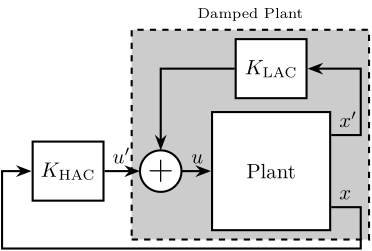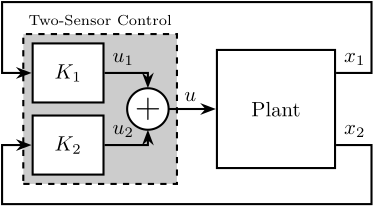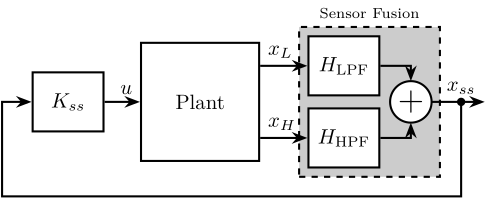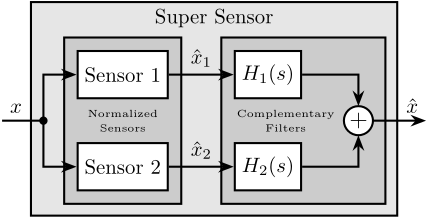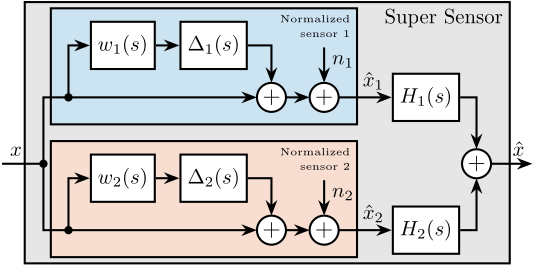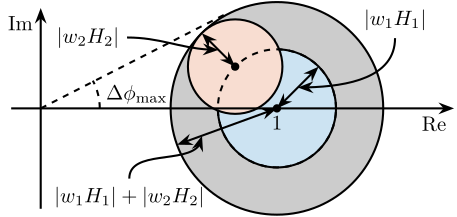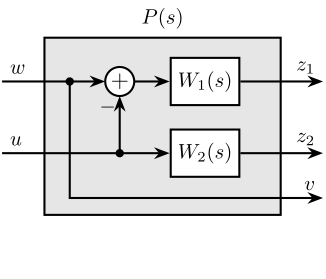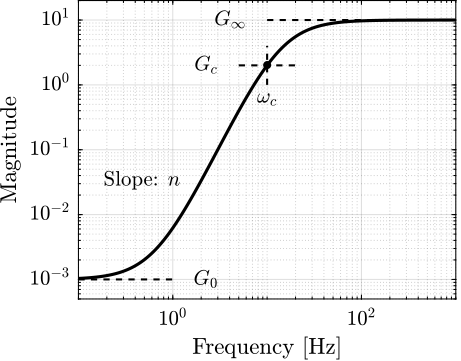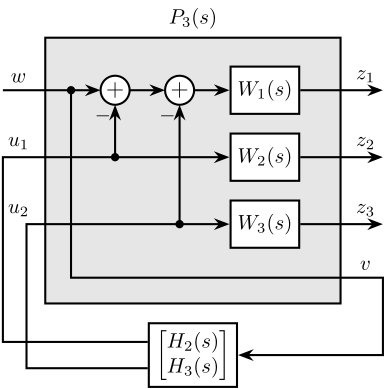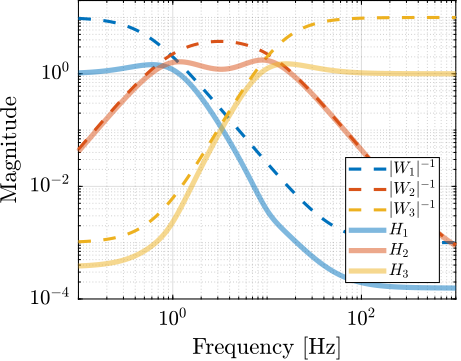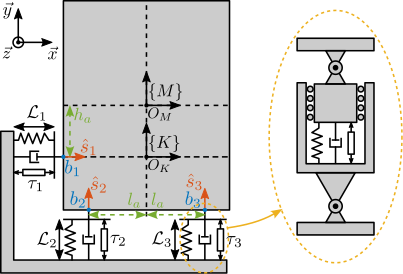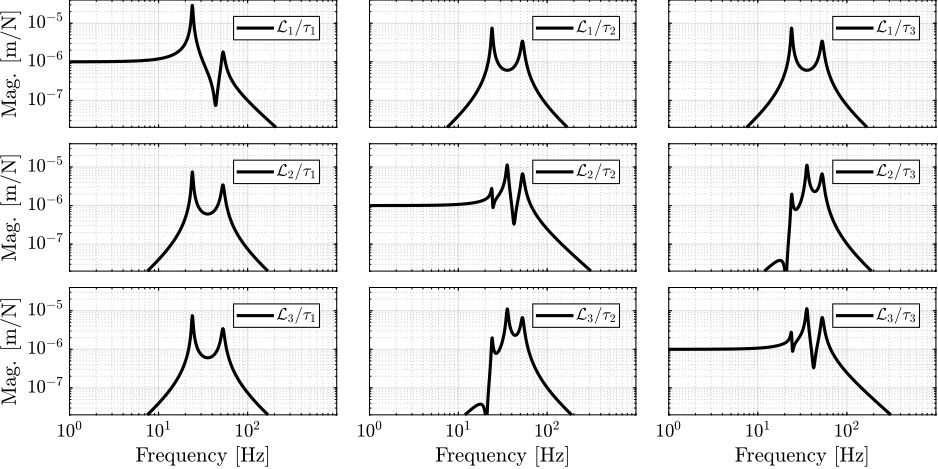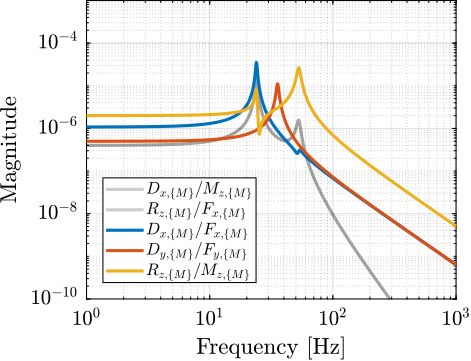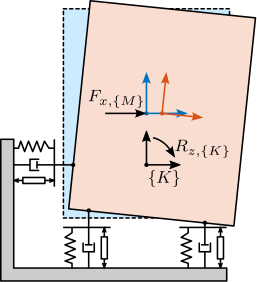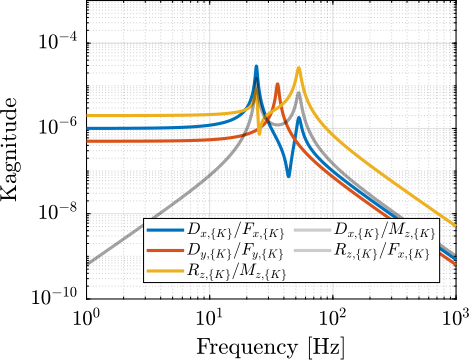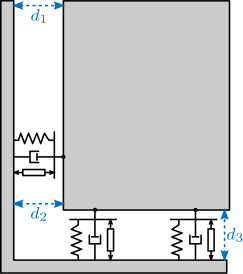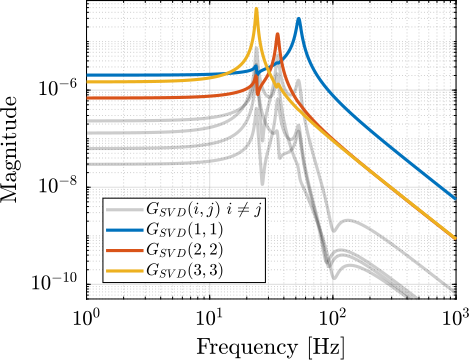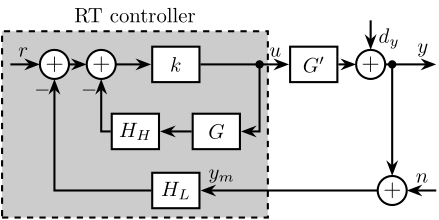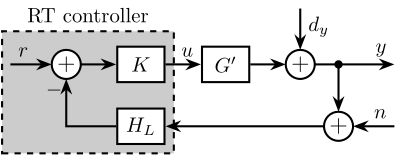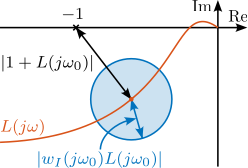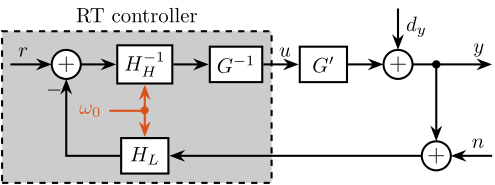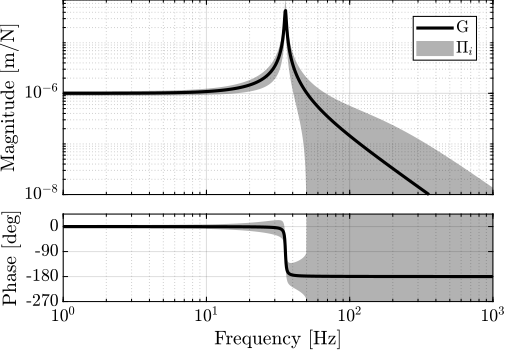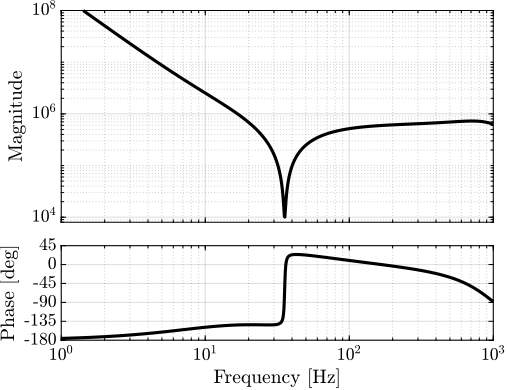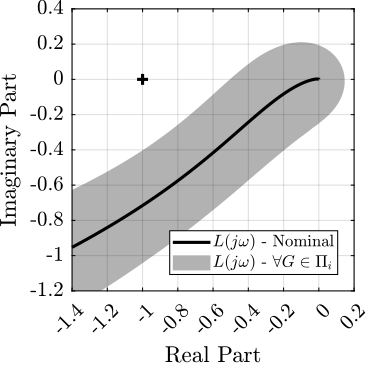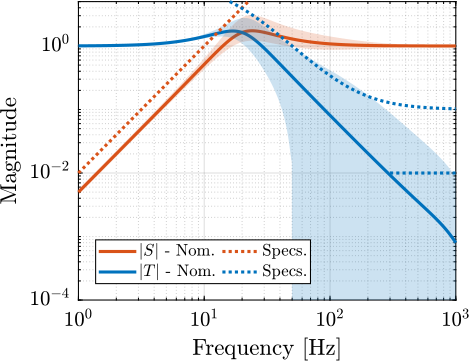239 KiB
Control of Parallel Manipulators
- Introduction
- Multiple Sensor Control
- Decoupling
- Closed-Loop Shaping using Complementary Filters
- Conclusion
- Bibliography
- Footnotes
Introduction ignore
Three critical elements for the control of parallel manipulators such as the Nano-Hexapod were identified: effective utilization and combination of multiple sensors, appropriate plant decoupling strategies, and robust controller design for the decoupled system.
During the conceptual design phase of the NASS, pragmatic approaches were implemented for each of these elements. The High Authority Control-Low Authority Control (HAC-LAC) architecture was selected for combining sensors. Control was implemented in the frame of the struts, leveraging the inherent low-frequency decoupling of the plant where all decoupled elements exhibited similar dynamics, thereby simplifying the Single-Input Single-Output (SISO) controller design process. For these decoupled plants, open-loop shaping techniques were employed to tune the individual controllers.
While these initial strategies proved effective in validating the NASS concept, this work explores alternative approaches with the potential to further enhance the performance. Section ref:sec:detail_control_sensor examines different methods for combining multiple sensors, with particular emphasis on sensor fusion techniques that utilize complementary filters. A novel approach for designing these filters is proposed, which allows optimization of the sensor fusion effectiveness.
Section ref:sec:detail_control_decoupling presents a comparative analysis of various decoupling strategies, including Jacobian decoupling, modal decoupling, and Singular Value Decomposition (SVD) decoupling. Each method is evaluated in terms of its theoretical foundations, implementation requirements, and performance characteristics, providing insights into their respective advantages for different applications.
Finally, Section ref:sec:detail_control_cf addresses the challenge of controller design for decoupled plants. A method for directly shaping closed-loop transfer functions using complementary filters is proposed, offering an intuitive approach to achieving desired performance specifications while ensuring robustness to plant uncertainty.
Multiple Sensor Control
<<sec:detail_control_sensor>>
Introduction ignore
The literature review of Stewart platforms revealed a wide diversity of designs with various sensor and actuator configurations. Control objectives (such as active damping, vibration isolation, or precise positioning) directly dictate sensor selection, whether inertial, force, or relative position sensors.
In cases where multiple control objectives must be achieved simultaneously, as is the case for the Nano Active Stabilization System (NASS) where the Stewart platform must both position the sample and provide isolation from micro-station vibrations, combining multiple sensors within the control architecture has been demonstrated to yield significant performance benefits cite:&hauge04_sensor_contr_space_based_six. From the literature, three principal approaches for combining sensors have been identified: High Authority Control-Low Authority Control (HAC-LAC), sensor fusion, and two-sensor control architectures.
\begin{tikzpicture}
% Blocs
\node[block={2.0cm}{2.0cm}] (P) {Plant};
\coordinate[] (input) at ($(P.south west)!0.5!(P.north west)$);
\coordinate[] (outputH) at ($(P.south east)!0.2!(P.north east)$);
\coordinate[] (outputL) at ($(P.south east)!0.8!(P.north east)$);
\node[block, above=0.2 of P] (Klac) {$K_\text{LAC}$};
\node[addb, left=0.5 of input] (addF) {};
\node[block, left=0.6 of addF] (Khac) {$K_\text{HAC}$};
% \node[addb={+}{}{}{}{-}, left=0.5 of Khac] (subr) {};
% Connections and labels
\draw[->] (outputL) -- ++(0.5, 0) coordinate(eastlac) |- (Klac.east);
\node[above right] at (outputL){$x^\prime$};
\draw[->] (Klac.west) -| (addF.north);
\draw[->] (addF.east) -- (input) node[above left]{$u$};
% \draw[<-] (subr.west)node[above left]{$r$} -- ++(-0.5, 0);
% \draw[->] (outputH) -- ++(0.5, 0) -- ++(0, -1.0) -| (subr.south);
\draw[->] (outputH) -- ++(0.5, 0) -- ++(0, -0.7) -| ($(Khac.west)+(-0.5, 0)$) -- (Khac.west);
\node[above right] at (outputH){$x$};
% \draw[->] (subr.east) -- (Khac.west) node[above left]{$\epsilon$};
\draw[->] (Khac.east) node[above right]{$u^\prime$} -- (addF.west);
\begin{scope}[on background layer]
\node[fit={(Klac.north-|eastlac) (addF.west|-P.south)}, fill=black!20!white, draw, dashed, inner sep=4pt] (Pi) {};
% \node[anchor={north west}, align=left] at (Pi.north west){\scriptsize{Damped}\\\scriptsize{Plant}};
\node[above=0 of Pi]{\scriptsize{Damped Plant}};
\end{scope}
\end{tikzpicture}\begin{tikzpicture}
% Blocs
\node[block={2.0cm}{2.0cm}] (P) {Plant};
\coordinate[] (input) at ($(P.south west)!0.5!(P.north west)$);
\coordinate[] (outputH) at ($(P.south east)!0.2!(P.north east)$);
\coordinate[] (outputL) at ($(P.south east)!0.8!(P.north east)$);
\coordinate[] (outputSS) at ($(P.south east)!0.5!(P.north east)$);
\node[block, right=0.8 of outputH] (KH) {$H_\text{HPF}$};
\node[block, right=0.8 of outputL] (KL) {$H_\text{LPF}$};
\node[addb={+}{}{}{}{}, right=2.2 of outputSS] (addss) {};
\node[block, left=0.6 of input] (K) {$K_{ss}$};
% Connections and labels
\draw[->] (outputL) -- (KL.west);
\draw[->] (outputH) -- (KH.west);
\node[above right] at (outputL){$x_L$};
\node[above right] at (outputH){$x_H$};
\draw[->] (KL.east) -| (addss.north);
\draw[->] (KH.east) -| (addss.south);
\draw[->] (addss.east) -- ++(0.9, 0);
\draw[->] ($(addss.east) + (0.5, 0)$)node[branch]{}node[above]{$x_{ss}$} -- ++(0, -1.6) -| ($(K.west)+(-0.5, 0)$) -- (K.west);
\draw[->] (K.east) -- (input) node[above left]{$u$};
\begin{scope}[on background layer]
\node[fit={(KL.north west) (KH.south-|addss.east)}, fill=black!20!white, draw, dashed, inner sep=4pt] (Pss) {};
\node[above=0 of Pss]{\scriptsize{Sensor Fusion}};
\end{scope}
\end{tikzpicture}\begin{tikzpicture}
% Blocs
\node[block={2.0cm}{2.0cm}] (P) {Plant};
\coordinate[] (input) at ($(P.south west)!0.5!(P.north west)$);
\coordinate[] (output1) at ($(P.south east)!0.8!(P.north east)$);
\coordinate[] (output2) at ($(P.south east)!0.2!(P.north east)$);
\node[addb={+}{}{}{}{}, left=0.8 of input] (addF) {};
\coordinate[left= 1.0 of addF] (Ks);
\node[block] (K1) at (Ks|-output1) {$K_\text{1}$};
\node[block] (K2) at (Ks|-output2) {$K_\text{2}$};
\draw[->] (output1) -| ++(0.6, 1.2) -| ($(K1.west)+(-0.5, 0)$) -- (K1.west);
\draw[->] (output2) -| ++(0.6,-1.0) -| ($(K2.west)+(-0.5, 0)$) -- (K2.west);
\draw[->] (K1.east)node[above right]{$u_1$} -| (addF.north);
\draw[->] (K2.east)node[above right]{$u_2$} -| (addF.south);
\draw[->] (addF.east) -- (input) node[above left=0 and 0.2]{$u$};
\node[above right] at (output1){$x_1$};
\node[above right] at (output2){$x_2$};
\begin{scope}[on background layer]
\node[fit={(K1.north west) (K2.south-|addF.east)}, fill=black!20!white, draw, dashed, inner sep=4pt] (Pss) {};
\node[above=0 of Pss]{\scriptsize{Two-Sensor Control}};
\end{scope}
\end{tikzpicture}The HAC-LAC approach employs a dual-loop control strategy in which two control loops utilize different sensors for distinct purposes (Figure ref:fig:detail_control_sensor_arch_hac_lac). In cite:&li01_simul_vibrat_isolat_point_contr, vibration isolation is provided by accelerometers collocated with the voice coil actuators, while external rotational sensors are utilized to achieve pointing control. In cite:&geng95_intel_contr_system_multip_degree, force sensors collocated with the magnetostrictive actuators are used for active damping using decentralized IFF, and subsequently accelerometers are employed for adaptive vibration isolation. Similarly, in cite:&wang16_inves_activ_vibrat_isolat_stewar, piezoelectric actuators with collocated force sensors are used in a decentralized manner to provide active damping while accelerometers are implemented in an adaptive feedback loop to suppress periodic vibrations. In cite:&xie17_model_contr_hybrid_passiv_activ, force sensors are integrated in the struts for decentralized force feedback while accelerometers fixed to the top platform are employed for centralized control.
The second approach, sensor fusion (illustrated in Figure ref:fig:detail_control_sensor_arch_sensor_fusion), involves filtering signals from two sensors using complementary filters1 and summing them to create an improved sensor signal. In cite:&hauge04_sensor_contr_space_based_six, geophones (used at low frequency) are merged with force sensors (used at high frequency). It is demonstrated that combining both sensors using sensor fusion can improve performance compared to using only one of the two sensors. In cite:&tjepkema12_sensor_fusion_activ_vibrat_isolat_precis_equip, sensor fusion architecture is implemented with an accelerometer and a force sensor. This implementation is shown to simultaneously achieve high damping of structural modes (through the force sensors) while maintaining very low vibration transmissibility (through the accelerometers).
In cite:&beijen14_two_sensor_contr_activ_vibrat, the performance of sensor fusion is compared with the more general case of "two-sensor control" (illustrated in Figure ref:fig:detail_control_sensor_arch_two_sensor_control). It is highlighted that "two-sensor control" provides greater control freedom, potentially enhancing performance. In cite:&thayer02_six_axis_vibrat_isolat_system, the use of force sensors and geophones is compared for vibration isolation purposes. Geophones are shown to provide better isolation performance than load cells but suffer from poor robustness. Conversely, the controller based on force sensors exhibited inferior performance (due to the presence of a pair of low frequency zeros), but demonstrated better robustness properties. A "two-sensor control" approach was proven to perform better than controllers based on individual sensors while maintaining better robustness. A Linear Quadratic Regulator (LQG) was employed to optimize the two-input/one-output controller.
Beyond these three main approaches, other control architectures have been proposed for different purposes. For instance, in cite:&yang19_dynam_model_decoup_contr_flexib, a first control loop utilizes force sensors and relative motion sensors to compensate for parasitic stiffness of the flexible joints. Subsequently, the system is decoupled in the modal space (facilitated by the removal of parasitic stiffness) and accelerometers are employed for vibration isolation.
The HAC-LAC architecture was previously investigated during the conceptual phase and successfully implemented to validate the NASS concept, demonstrating excellent performance. At the other end of the spectrum, the two-sensor approach yields greater control design freedom but introduces increased complexity in tuning, and thus was not pursued in this study. This work instead focuses on sensor fusion, which represents a promising middle ground between the proven HAC-LAC approach and the more complex two-sensor control strategy.
A review of sensor fusion is first presented in Section ref:ssec:detail_control_sensor_review. Then, in Section ref:ssec:detail_control_sensor_fusion_requirements, both the robustness of the fusion and the noise characteristics of the resulting "fused sensor" are derived and expressed as functions of the complementary filters' norms. A synthesis method for shaping complementary filters is proposed in Section ref:ssec:detail_control_sensor_hinf_method. The investigation is then extended beyond the conventional two-sensor scenario, demonstrating how the proposed complementary filter synthesis can be generalized for applications requiring the fusion of three or more sensors (Section ref:ssec:detail_control_sensor_hinf_three_comp_filters).
Review of Sensor Fusion
<<ssec:detail_control_sensor_review>>
Measuring a physical quantity using sensors is always subject to several limitations. First, the accuracy of the measurement is affected by various noise sources, such as electrical noise from the conditioning electronics. Second, the frequency range in which the measurement is relevant is bounded by the bandwidth of the sensor. One way to overcome these limitations is to combine several sensors using a technique called "sensor fusion" cite:&bendat57_optim_filter_indep_measur_two. Fortunately, a wide variety of sensors exists, each with different characteristics. By carefully selecting the sensors to be fused, a "super sensor" is obtained that combines the benefits of the individual sensors.
In some applications, sensor fusion is employed to increase measurement bandwidth cite:&shaw90_bandw_enhan_posit_measur_using_measur_accel;&zimmermann92_high_bandw_orien_measur_contr;&min15_compl_filter_desig_angle_estim. For instance, in cite:&shaw90_bandw_enhan_posit_measur_using_measur_accel, the bandwidth of a position sensor is extended by fusing it with an accelerometer that provides high-frequency motion information. In other applications, sensor fusion is utilized to obtain an estimate of the measured quantity with reduced noise cite:&hua05_low_ligo;&hua04_polyp_fir_compl_filter_contr_system;&plummer06_optim_compl_filter_their_applic_motion_measur;&robert12_introd_random_signal_applied_kalman. More recently, the fusion of sensors measuring different physical quantities has been proposed to enhance control properties cite:&collette15_sensor_fusion_method_high_perfor;&yong16_high_speed_vertic_posit_stage. In cite:&collette15_sensor_fusion_method_high_perfor, an inertial sensor used for active vibration isolation is fused with a sensor collocated with the actuator to improve the stability margins of the feedback controller.
Beyond Stewart platforms, practical applications of sensor fusion are numerous. It is widely implemented for attitude estimation in autonomous vehicles such as unmanned aerial vehicles cite:&baerveldt97_low_cost_low_weigh_attit;&corke04_inert_visual_sensin_system_small_auton_helic;&jensen13_basic_uas and underwater vehicles cite:&pascoal99_navig_system_desig_using_time;&batista10_optim_posit_veloc_navig_filter_auton_vehic. Sensor fusion offers significant benefits for high-performance positioning control as demonstrated in cite:&shaw90_bandw_enhan_posit_measur_using_measur_accel;&zimmermann92_high_bandw_orien_measur_contr;&min15_compl_filter_desig_angle_estim;&yong16_high_speed_vertic_posit_stage. It has also been identified as a key technology for improving the performance of active vibration isolation systems cite:&tjepkema12_sensor_fusion_activ_vibrat_isolat_precis_equip. Emblematic examples include the isolation stages of gravitational wave detectors cite:&collette15_sensor_fusion_method_high_perfor;&heijningen18_low such as those employed at LIGO cite:&hua05_low_ligo;&hua04_polyp_fir_compl_filter_contr_system and Virgo cite:&lucia18_low_frequen_optim_perfor_advan.
Two principal methods are employed to perform sensor fusion: using complementary filters cite:&anderson53_instr_approac_system_steer_comput or using Kalman filtering cite:&brown72_integ_navig_system_kalman_filter. For sensor fusion applications, these methods share many relationships cite:&brown72_integ_navig_system_kalman_filter;&higgins75_compar_compl_kalman_filter;&robert12_introd_random_signal_applied_kalman;&fonseca15_compl. However, Kalman filtering requires assumptions about the probabilistic characteristics of sensor noise cite:&robert12_introd_random_signal_applied_kalman, whereas complementary filters do not impose such requirements. Furthermore, complementary filters offer advantages over Kalman filtering for sensor fusion through their general applicability, low computational cost cite:&higgins75_compar_compl_kalman_filter, and intuitive nature, as their effects can be readily interpreted in the frequency domain.
A set of filters is considered complementary if the sum of their transfer functions equals one at all frequencies. In early implementations of complementary filtering, analog circuits were used to physically realize the filters cite:&anderson53_instr_approac_system_steer_comput. While analog complementary filters remain in use today cite:&yong16_high_speed_vertic_posit_stage;&moore19_capac_instr_sensor_fusion_high_bandw_nanop, digital implementation is now more common as it provides greater flexibility.
Various design methods have been developed to optimize complementary filters. The most straightforward approach utilizes analytical formulas, which depending on the application may be first order cite:&corke04_inert_visual_sensin_system_small_auton_helic;&yeh05_model_contr_hydraul_actuat_two;&yong16_high_speed_vertic_posit_stage, second order cite:&baerveldt97_low_cost_low_weigh_attit;&stoten01_fusion_kinet_data_using_compos_filter;&jensen13_basic_uas, or higher orders cite:&shaw90_bandw_enhan_posit_measur_using_measur_accel;&zimmermann92_high_bandw_orien_measur_contr;&stoten01_fusion_kinet_data_using_compos_filter;&collette15_sensor_fusion_method_high_perfor;&matichard15_seism_isolat_advan_ligo. Since the characteristics of the super sensor depend on proper complementary filter design cite:&dehaeze19_compl_filter_shapin_using_synth, several optimization techniques have emerged—ranging from optimizing parameters for analytical formulas cite:&jensen13_basic_uas;&min15_compl_filter_desig_angle_estim;&fonseca15_compl to employing convex optimization tools cite:&hua04_polyp_fir_compl_filter_contr_system;&hua05_low_ligo such as linear matrix inequalities cite:&pascoal99_navig_system_desig_using_time. As demonstrated in cite:&plummer06_optim_compl_filter_their_applic_motion_measur, complementary filter design can be linked to the standard mixed-sensitivity control problem, allowing powerful classical control theory tools to be applied. For example, in cite:&jensen13_basic_uas, two gains of a Proportional Integral (PI) controller are optimized to minimize super sensor noise.
All these complementary filter design methods share the common objective of creating a super sensor with desired characteristics, typically in terms of noise and dynamics. As reported in cite:&zimmermann92_high_bandw_orien_measur_contr;&plummer06_optim_compl_filter_their_applic_motion_measur, phase shifts and magnitude bumps in the super sensor dynamics may occur if complementary filters are poorly designed or if sensors are improperly calibrated. Therefore, the robustness of the fusion must be considered when designing complementary filters. Despite the numerous design methods proposed in the literature, a simple approach that specifies desired super sensor characteristics while ensuring good fusion robustness has been lacking.
Fortunately, both fusion robustness and super sensor characteristics can be linked to complementary filter magnitude cite:&dehaeze19_compl_filter_shapin_using_synth. Based on this relationship, the present work introduces an approach to designing complementary filters using $\mathcal{H}_\infty\text{-synthesis}$, which enables intuitive shaping of complementary filter magnitude in a straightforward manner.
Sensor Fusion and Complementary Filters Requirements
<<ssec:detail_control_sensor_fusion_requirements>>
Sensor Fusion Architecture ignore
A general sensor fusion architecture using complementary filters is shown in Figure ref:fig:detail_control_sensor_fusion_overview, where multiple sensors (in this case two) measure the same physical quantity $x$. The sensor output signals $\hat{x}_1$ and $\hat{x}_2$ represent estimates of $x$. These estimates are filtered by complementary filters and combined to form a new estimate $\hat{x}$.
\tikzset{block/.default={0.8cm}{0.8cm}}
\tikzset{addb/.append style={scale=0.7}}
\tikzset{node distance=0.6}
\begin{tikzpicture}
\node[branch] (x) at (0, 0);
\node[block, above right=0.3 and 0.5 of x](sensor1){Sensor 1};
\node[block, below right=0.3 and 0.5 of x](sensor2){Sensor 2};
\node[block, right=1.1 of sensor1](H1){$H_1(s)$};
\node[block, right=1.1 of sensor2](H2){$H_2(s)$};
\node[addb, right=5.0 of x](add){};
\draw[] ($(x)+(-0.7, 0)$) node[above right]{$x$} -- (x.center);
\draw[->] (x.center) |- (sensor1.west);
\draw[->] (x.center) |- (sensor2.west);
\draw[->] (sensor1.east) -- node[midway, above]{$\hat{x}_1$} (H1.west);
\draw[->] (sensor2.east) -- node[midway, above]{$\hat{x}_2$} (H2.west);
\draw[->] (H1) -| (add.north);
\draw[->] (H2) -| (add.south);
\draw[->] (add.east) -- ++(0.9, 0) node[above left]{$\hat{x}$};
\begin{scope}[on background layer]
\node[fit={($(H2.south-|x) + (0, -0.2)$) ($(H1.north-|add.east) + (0.2, 0.6)$)}, fill=black!10!white, draw, inner sep=6pt] (supersensor) {};
\node[below] at (supersensor.north) {Super Sensor};
\node[fit={(sensor2.south west) (sensor1.north east)}, fill=black!20!white, draw, inner sep=6pt] (sensors) {};
\node[align=center] at (sensors.center) {{\tiny Normalized}\\[-0.5em]{\tiny Sensors}};
\node[fit={(H2.south west) (H1.north-|add.east)}, fill=black!20!white, draw, inner sep=6pt] (filters) {};
\node[align=center] at ($(filters.center) + (-0.3, 0)$) {{\tiny Complementary}\\[-0.5em]{\tiny Filters}};
\end{scope}
\end{tikzpicture}The complementary property of filters $H_1(s)$ and $H_2(s)$ requires that the sum of their transfer functions equals one at all frequencies eqref:eq:detail_control_sensor_comp_filter.
\begin{equation}\label{eq:detail_control_sensor_comp_filter} H_1(s) + H_2(s) = 1
\end{equation}
Sensor Models and Sensor Normalization
To analyze sensor fusion architectures, appropriate sensor models are required. The model shown in Figure ref:fig:detail_control_sensor_model consists of a linear time invariant (LTI) system $G_i(s)$ representing the sensor dynamics and an input $n_i$ representing sensor noise. The model input $x$ is the measured physical quantity, and its output $\tilde{x}_i$ is the "raw" output of the sensor.
Prior to filtering the sensor outputs $\tilde{x}_i$ with complementary filters, the sensors are typically normalized to simplify the fusion process. This normalization involves using an estimate $\hat{G}_i(s)$ of the sensor dynamics $G_i(s)$, and filtering the sensor output by the inverse of this estimate $\hat{G}_i^{-1}(s)$, as shown in Figure ref:fig:detail_control_sensor_model_calibrated. It is assumed that the sensor inverse $\hat{G}_i^{-1}(s)$ is proper and stable. This approach ensures that the units of the estimates $\hat{x}_i$ match the units of the physical quantity $x$. The sensor dynamics estimate $\hat{G}_i(s)$ may be a simple gain or a more complex transfer function.
\tikzset{block/.default={0.8cm}{0.8cm}}
\tikzset{addb/.append style={scale=0.7}}
\tikzset{node distance=0.6}
\begin{tikzpicture}
\node[addb](add1){};
\node[block, right=0.8 of add1](G1){$G_i(s)$};
\draw[->] ($(add1.west)+(-0.7, 0)$) node[above right]{$x$} -- (add1.west);
\draw[<-] (add1.north) -- ++(0, 0.7)node[below right](n1){$n_i$};
\draw[->] (add1.east) -- (G1.west);
\draw[->] (G1.east) -- ++(0.7, 0) node[above left]{$\tilde{x}_i$};
\begin{scope}[on background layer]
\node[fit={(add1.west |- G1.south) (n1.north -| G1.east)}, fill=black!20!white, draw, inner sep=3pt] (sensor1) {};
\node[below left] at (sensor1.north east) {Sensor};
\end{scope}
\end{tikzpicture}\tikzset{block/.default={0.8cm}{0.8cm}}
\tikzset{addb/.append style={scale=0.7}}
\tikzset{node distance=0.6}
\begin{tikzpicture}
\node[addb](add1){};
\node[block, right=0.8 of add1](G1){$G_i(s)$};
\node[block, right=0.8 of G1](G1inv){$\hat{G}_i^{-1}(s)$};
\draw[->] ($(add1.west)+(-0.7, 0)$) node[above right]{$x$} -- (add1.west);
\draw[<-] (add1.north) -- ++(0, 0.7)node[below right](n1){$n_i$};
\draw[->] (add1.east) -- (G1.west);
\draw[->] (G1.east) -- (G1inv.west) node[above left]{$\tilde{x}_i$};
\draw[->] (G1inv.east) -- ++(0.8, 0) node[above left]{$\hat{x}_i$};
\begin{scope}[on background layer]
\node[fit={(add1.west |- G1inv.south) (n1.north -| G1inv.east)}, fill=black!10!white, draw, inner sep=6pt] (sensor1cal) {};
\node[below left, align=right] at (sensor1cal.north east) {{\tiny Normalized}\\[-0.5em]{\tiny sensor}};
\node[fit={(add1.west |- G1.south) (n1.north -| G1.east)}, fill=black!20!white, draw, inner sep=3pt] (sensor1) {};
\node[below left] at (sensor1.north east) {Sensor};
\end{scope}
\end{tikzpicture}Two normalized sensors are then combined to form a super sensor as shown in Figure ref:fig:detail_control_sensor_fusion_super_sensor. The two sensors measure the same physical quantity $x$ with dynamics $G_1(s)$ and $G_2(s)$, and with uncorrelated noises $n_1$ and $n_2$. The signals from both normalized sensors are fed into two complementary filters $H_1(s)$ and $H_2(s)$ and then combined to yield an estimate $\hat{x}$ of $x$. The super sensor output $\hat{x}$ is therefore described by eqref:eq:detail_control_sensor_comp_filter_estimate.
\begin{equation}\label{eq:detail_control_sensor_comp_filter_estimate} \hat{x} = \Big( H_1(s) \hat{G}_1-1(s) G_1(s) + H_2(s) \hat{G}_2-1(s) G_2(s) \Big) x + H_1(s) \hat{G}_1-1(s) G_1(s) n_1 + H_2(s) \hat{G}_2-1(s) G_2(s) n_2
\end{equation}
\tikzset{block/.default={0.8cm}{0.8cm}}
\tikzset{addb/.append style={scale=0.7}}
\tikzset{node distance=0.6}
\begin{tikzpicture}
\node[branch] (x) at (0, 0);
\node[addb, above right=0.8 and 0.5 of x](add1){};
\node[addb, below right=0.8 and 0.5 of x](add2){};
\node[block, right=0.8 of add1](G1){$G_1(s)$};
\node[block, right=0.8 of add2](G2){$G_2(s)$};
\node[block, right=0.8 of G1](G1inv){$\hat{G}_1^{-1}(s)$};
\node[block, right=0.8 of G2](G2inv){$\hat{G}_2^{-2}(s)$};
\node[block, right=0.8 of G1inv](H1){$H_1(s)$};
\node[block, right=0.8 of G2inv](H2){$H_2(s)$};
\node[addb, right=7 of x](add){};
\draw[] ($(x)+(-0.7, 0)$) node[above right]{$x$} -- (x.center);
\draw[->] (x.center) |- (add1.west);
\draw[->] (x.center) |- (add2.west);
\draw[<-] (add1.north) -- ++(0, 0.7)node[below right](n1){$n_1$};
\draw[->] (add1.east) -- (G1.west);
\draw[->] (G1.east) -- (G1inv.west) node[above left]{$\tilde{x}_1$};
\draw[->] (G1inv.east) -- (H1.west) node[above left]{$\hat{x}_1$};
\draw[<-] (add2.north) -- ++(0, 0.7)node[below right](n2){$n_2$};
\draw[->] (add2.east) -- (G2.west);
\draw[->] (G2.east) -- (G2inv.west) node[above left]{$\tilde{x}_2$};
\draw[->] (G2inv.east) -- (H2.west) node[above left]{$\hat{x}_2$};
\draw[->] (H1) -| (add.north);
\draw[->] (H2) -| (add.south);
\draw[->] (add.east) -- ++(0.7, 0) node[above left]{$\hat{x}$};
\begin{scope}[on background layer]
\node[fit={(G2.south-|x) (n1.north-|add.east)}, fill=black!10!white, draw, inner sep=9pt] (supersensor) {};
\node[below left] at (supersensor.north east) {Super Sensor};
\node[fit={(add1.west |- G1inv.south) (n1.north -| G1inv.east)}, fill=colorblue!20!white, draw, inner sep=6pt] (sensor1cal) {};
\node[below left, align=right] at (sensor1cal.north east) {{\tiny Normalized}\\[-0.5em]{\tiny sensor}};
\node[fit={(add1.west |- G1.south) (n1.north -| G1.east)}, fill=colorblue!30!white, draw, inner sep=3pt] (sensor1) {};
\node[below left] at (sensor1.north east) {Sensor 1};
\node[fit={(add2.west |- G2inv.south) (n2.north -| G2inv.east)}, fill=colorred!20!white, draw, inner sep=6pt] (sensor2cal) {};
\node[below left, align=right] at (sensor2cal.north east) {{\tiny Normalized}\\[-0.5em]{\tiny sensor}};
\node[fit={(add2.west |- G2.south) (n2.north -| G2.east)}, fill=colorred!30!white, draw, inner sep=3pt] (sensor2) {};
\node[below left] at (sensor2.north east) {Sensor 2};
\end{scope}
\end{tikzpicture}Noise Sensor Filtering
First, consider the case where all sensors are perfectly normalized eqref:eq:detail_control_sensor_perfect_dynamics. The effects of imperfect normalization will be addressed subsequently.
\begin{equation}\label{eq:detail_control_sensor_perfect_dynamics} \frac{\hat{x}_i}{x} = \hat{G}_i(s) G_i(s) = 1
\end{equation}
In that case, the super sensor output $\hat{x}$ equals $x$ plus the filtered noise from both sensors eqref:eq:detail_control_sensor_estimate_perfect_dyn. From this equation, it is evident that the complementary filters $H_1(s)$ and $H_2(s)$ operate solely on the sensor noise. Thus, this sensor fusion architecture allows filtering of sensor noise without introducing distortion in the measured physical quantity. This fundamental property necessitates that the two filters are complementary.
\begin{equation}\label{eq:detail_control_sensor_estimate_perfect_dyn} \hat{x} = x + H_1(s) n_1 + H_2(s) n_2
\end{equation}
The estimation error $\epsilon_x$, defined as the difference between the sensor output $\hat{x}$ and the measured quantity $x$, is computed for the super sensor eqref:eq:detail_control_sensor_estimate_error.
\begin{equation}\label{eq:detail_control_sensor_estimate_error} ε_x ≜ \hat{x} - x = H_1(s) n_1 + H_2(s) n_2
\end{equation}
As shown in eqref:eq:detail_control_sensor_noise_filtering_psd, the Power Spectral Density (PSD) of the estimation error $\Phi_{\epsilon_x}$ depends both on the norm of the two complementary filters and on the PSD of the noise sources $\Phi_{n_1}$ and $\Phi_{n_2}$.
\begin{equation}\label{eq:detail_control_sensor_noise_filtering_psd} Φε_x(ω) = ≤ft|H_1(jω)\right|^2 Φn_1(ω) + ≤ft|H_2(jω)\right|^2 Φn_2(ω)
\end{equation}
If the two sensors have identical noise characteristics ($\Phi_{n_1}(\omega) = \Phi_{n_2}(\omega)$), simple averaging ($H_1(s) = H_2(s) = 0.5$) would minimize the super sensor noise. This represents the simplest form of sensor fusion using complementary filters.
However, sensors typically exhibit high noise levels in different frequency regions. In such cases, to reduce the noise of the super sensor, $|H_1(j\omega)|$ should be minimized when $\Phi_{n_1}(\omega)$ exceeds $\Phi_{n_2}(\omega)$, and $|H_2(j\omega)|$ should be minimized when $\Phi_{n_2}(\omega)$ exceeds $\Phi_{n_1}(\omega)$. Therefore, by appropriately shaping the norm of the complementary filters, the noise of the super sensor can be minimized.
Sensor Fusion Robustness
In practical systems, sensor normalization is rarely perfect, and condition eqref:eq:detail_control_sensor_perfect_dynamics is not fully satisfied. To analyze such imperfections, a multiplicative input uncertainty is incorporated into the sensor dynamics (Figure ref:fig:detail_control_sensor_model_uncertainty). The nominal model is the estimated model used for normalization $\hat{G}_i(s)$, $\Delta_i(s)$ is any stable transfer function satisfying $|\Delta_i(j\omega)| \le 1,\ \forall\omega$, and $w_i(s)$ is a weighting transfer function representing the magnitude of uncertainty.
Since the nominal sensor dynamics is taken as the normalized filter, the normalized sensor model can be further simplified as shown in Figure ref:fig:detail_control_sensor_model_uncertainty_simplified.
\tikzset{block/.default={0.8cm}{0.8cm}}
\tikzset{addb/.append style={scale=0.7}}
\tikzset{node distance=0.6}
\begin{tikzpicture}
\node[branch] (input) at (0,0) {};
\node[block, above right= 0.4 and 0.4 of input](W1){$w_1(s)$};
\node[block, right=0.4 of W1](delta1){$\Delta_1(s)$};
\node[addb] (addu) at ($(delta1.east|-input) + (0.4, 0)$) {};
\node[addb, right=0.4 of addu] (addn) {};
\node[block, right=0.4 of addn] (G1) {$\hat{G}_1(s)$};
\node[block, right=0.8 of G1](G1inv){$\hat{G}_1^{-1}(s)$};
\draw[->] ($(input)+(-0.7, 0)$) node[above right]{$x$} -- (addu);
\draw[->] (input.center) |- (W1.west);
\draw[->] (W1.east) -- (delta1.west);
\draw[->] (delta1.east) -| (addu.north);
\draw[->] (addu.east) -- (addn.west);
\draw[->] (addn.east) -- (G1.west);
\draw[<-] (addn.north) -- ++(0, 0.7)node[below right](n1){$n_1$};
\draw[->] (G1.east) -- (G1inv.west) node[above left]{$\tilde{x}_1$};
\draw[->] (G1inv.east) -- ++(0.8, 0) node[above left]{$\hat{x}_1$};
\begin{scope}[on background layer]
\node[fit={(input.west |- G1inv.south) (delta1.north -| G1inv.east)}, fill=black!10!white, draw, inner sep=6pt] (sensor1cal) {};
\node[below left, align=right] at (sensor1cal.north east) {{\tiny Normalized}\\[-0.5em]{\tiny sensor}};
\node[fit={(input.west |- G1.south) (delta1.north -| G1.east)}, fill=black!20!white, draw, inner sep=3pt] (sensor1) {};
\node[below left] at (sensor1.north east) {Sensor};
\end{scope}
\end{tikzpicture}\tikzset{block/.default={0.8cm}{0.8cm}}
\tikzset{addb/.append style={scale=0.7}}
\tikzset{node distance=0.6}
\begin{tikzpicture}
\node[branch] (input) at (0,0) {};
\node[block, above right= 0.4 and 0.4 of input](W1){$w_1(s)$};
\node[block, right=0.4 of W1](delta1){$\Delta_1(s)$};
\node[addb] (addu) at ($(delta1.east|-input) + (0.4, 0)$) {};
\node[addb, right=0.4 of addu] (addn) {};
\draw[->] ($(input)+(-0.8, 0)$) node[above right]{$x$} -- (addu);
\draw[->] (input.center) |- (W1.west);
\draw[->] (W1.east) -- (delta1.west);
\draw[->] (delta1.east) -| (addu.north);
\draw[->] (addu.east) -- (addn.west);
\draw[<-] (addn.north) -- ++(0, 0.6)node[below right](n1){$n_1$};
\draw[->] (addn.east) -- ++(0.9, 0) node[above left]{$\hat{x}_1$};
\begin{scope}[on background layer]
\node[fit={(input.west |- addu.south) ($(delta1.north -| addn.east) + (0.1, 0)$)}, fill=black!10!white, draw, inner sep=6pt] (sensor1cal) {};
\node[below left, align=right] at (sensor1cal.north east) {{\tiny Normalized}\\[-0.5em]{\tiny sensor}};
\end{scope}
\end{tikzpicture}The sensor fusion architecture incorporating sensor models with dynamical uncertainty is illustrated in Figure ref:fig:detail_control_sensor_fusion_dynamic_uncertainty. The super sensor dynamics eqref:eq:detail_control_sensor_super_sensor_dyn_uncertainty is no longer unity but depends on the sensor dynamical uncertainty weights $w_i(s)$ and the complementary filters $H_i(s)$. The dynamical uncertainty of the super sensor can be graphically represented in the complex plane by a circle centered on $1$ with a radius equal to $|w_1(j\omega) H_1(j\omega)| + |w_2(j\omega) H_2(j\omega)|$ (Figure ref:fig:detail_control_sensor_uncertainty_set_super_sensor).
\begin{equation}\label{eq:detail_control_sensor_super_sensor_dyn_uncertainty} \frac{\hat{x}}{x} = 1 + w_1(s) H_1(s) Δ_1(s) + w_2(s) H_2(s) Δ_2(s)
\end{equation}
\tikzset{block/.default={0.8cm}{0.8cm}}
\tikzset{addb/.append style={scale=0.7}}
\tikzset{node distance=0.6}
\begin{tikzpicture}
\node[branch] (x) at (0, 0);
\node[branch, above right=1.0 and 0.3 of x] (input1) {};
\node[branch, below right=1.0 and 0.3 of x] (input2) {};
\node[block, above right= 0.4 and 0.3 of input1](W1){$w_1(s)$};
\node[block, above right= 0.4 and 0.3 of input2](W2){$w_2(s)$};
\node[block, right=0.4 of W1](delta1){$\Delta_1(s)$};
\node[block, right=0.4 of W2](delta2){$\Delta_2(s)$};
\node[addb] (addu1) at ($(delta1.east|-input1) + (0.4, 0)$) {};
\node[addb] (addu2) at ($(delta2.east|-input2) + (0.4, 0)$) {};
\node[addb, right=0.4 of addu1] (addn1) {};
\node[addb, right=0.4 of addu2] (addn2) {};
\node[block, right=0.9 of addn1](H1){$H_1(s)$};
\node[block, right=0.9 of addn2](H2){$H_2(s)$};
\node[addb, right=7 of x](add){};
\draw[] ($(x)+(-0.7, 0)$) node[above right]{$x$} -- (x.center);
\draw[->] (x.center) |- (addu1.west);
\draw[->] (x.center) |- (addu2.west);
\draw[->] (input1.center) |- (W1.west);
\draw[->] (W1.east) -- (delta1.west);
\draw[->] (delta1.east) -| (addu1.north);
\draw[->] (addu1.east) -- (addn1.west);
\draw[<-] (addn1.north) -- ++(0, 0.6)node[below right](n1){$n_1$};
\draw[->] (input2.center) |- (W2.west);
\draw[->] (W2.east) -- (delta2.west);
\draw[->] (delta2.east) -| (addu2.north);
\draw[->] (addu2.east) -- (addn2.west);
\draw[<-] (addn2.north) -- ++(0, 0.6)node[below right](n2){$n_2$};
\draw[->] (addn1.east) -- (H1.west) node[above left]{$\hat{x}_1$};
\draw[->] (addn2.east) -- (H2.west) node[above left]{$\hat{x}_2$};
\draw[->] (H1) -| (add.north);
\draw[->] (H2) -| (add.south);
\draw[->] (add.east) -- ++(0.7, 0) node[above left]{$\hat{x}$};
\begin{scope}[on background layer]
\node[fit={(addn2.south-|x) (delta1.north-|add.east)}, fill=black!10!white, draw, inner sep=9pt] (supersensor) {};
\node[below left] at (supersensor.north east) {Super Sensor};
\node[fit={(input1.west |- addu1.south) ($(delta1.north -| addn1.east) + (0.1, 0.0)$)}, fill=colorblue!20!white, draw, inner sep=6pt] (sensor1cal) {};
\node[below left, align=right] at (sensor1cal.north east) {{\tiny Normalized}\\[-0.5em]{\tiny sensor 1}};
\node[fit={(input2.west |- addu2.south) ($(delta2.north -| addn1.east) + (0.1, 0.0)$)}, fill=colorred!20!white, draw, inner sep=6pt] (sensor2cal) {};
\node[below left, align=right] at (sensor2cal.north east) {{\tiny Normalized}\\[-0.5em]{\tiny sensor 2}};
\end{scope}
\end{tikzpicture}\tikzset{block/.default={0.8cm}{0.8cm}}
\tikzset{addb/.append style={scale=0.7}}
\tikzset{node distance=0.6}
\begin{tikzpicture}
\begin{scope}[shift={(4, 0)}]
% Uncertainty Circle
\node[draw, circle, fill=black!20!white, minimum size=3.6cm] (c) at (0, 0) {};
\path[draw, fill=colorblue!20!white] (0, 0) circle [radius=1.0];
\path[draw, fill=colorred!20!white] (135:1.0) circle [radius=0.8];
\path[draw, dashed] (0, 0) circle [radius=1.0];
% Center of Circle
\node[below] at (0, 0){$1$};
\draw[<->] (0, 0) node[branch]{} -- coordinate[midway](r1) ++(45:1.0);
\draw[<->] (135:1.0)node[branch]{} -- coordinate[midway](r2) ++(135:0.8);
\node[] (l1) at (2, 1.5) {$|w_1 H_1|$};
\draw[->, out=-90, in=0] (l1.south) to (r1);
\node[] (l2) at (-3.2, 1.2) {$|w_2 H_2|$};
\draw[->, out=0, in=-180] (l2.east) to (r2);
\draw[<->] (0, 0) -- coordinate[near end](r3) ++(200:1.8);
\node[] (l3) at (-2.5, -1.5) {$|w_1 H_1| + |w_2 H_2|$};
\draw[->, out=90, in=-90] (l3.north) to (r3);
\end{scope}
% Real and Imaginary Axis
\draw[->] (-0.5, 0) -- (7.0, 0) node[below left]{Re};
\draw[->] (0, -1.7) -- (0, 1.7) node[below left]{Im};
\draw[dashed] (0, 0) -- (tangent cs:node=c,point={(0, 0)},solution=2);
\draw[dashed] (1, 0) arc (0:28:1) node[midway, right]{$\Delta \phi_\text{max}$};
\end{tikzpicture}The super sensor dynamical uncertainty, and consequently the robustness of the fusion, clearly depends on the complementary filters' norm. As it is generally desired to limit the dynamical uncertainty of the super sensor, the norm of the complementary filter $|H_i(j\omega)|$ should be made small when $|w_i(j\omega)|$ is large, i.e., at frequencies where the sensor dynamics is uncertain.
Complementary Filters Shaping
<<ssec:detail_control_sensor_hinf_method>>
Introduction ignore
As established in Section ref:ssec:detail_control_sensor_fusion_requirements, the super sensor's noise characteristics and robustness are directly dependent on the complementary filters' norm. A synthesis method enabling precise shaping of these norms would therefore offer substantial practical benefits. This section develops such an approach by formulating the design objective as a standard $\mathcal{H}_\infty$ optimization problem. The methodology for designing appropriate weighting functions (which specify desired complementary filter shape during synthesis) is examined in detail, and the efficacy of the proposed method is validated with a simple example.
Synthesis Objective
The primary objective is to shape the norms of two filters $H_1(s)$ and $H_2(s)$ while ensuring they maintain their complementary property as defined in eqref:eq:detail_control_sensor_comp_filter. This is equivalent to finding proper and stable transfer functions $H_1(s)$ and $H_2(s)$ that satisfy conditions eqref:eq:detail_control_sensor_hinf_cond_complementarity, eqref:eq:detail_control_sensor_hinf_cond_h1, and eqref:eq:detail_control_sensor_hinf_cond_h2. Weighting transfer functions $W_1(s)$ and $W_2(s)$ are strategically selected to define the maximum desired norm of the complementary filters during the synthesis process.
\begin{subequations}\label{eq:detail_control_sensor_comp_filter_problem_form}
\begin{align} & H_1(s) + H_2(s) = 1 \label{eq:detail_control_sensor_hinf_cond_complementarity} \\ & |H_1(j\omega)| \le \frac{1}{|W_1(j\omega)|} \quad \forall\omega \label{eq:detail_control_sensor_hinf_cond_h1} \\ & |H_2(j\omega)| \le \frac{1}{|W_2(j\omega)|} \quad \forall\omega \label{eq:detail_control_sensor_hinf_cond_h2} \end{align}\end{subequations}
Shaping of Complementary Filters using $\mathcal{H}_\infty$ synthesis
The synthesis objective can be expressed as a standard $\mathcal{H}_\infty$ optimization problem by considering the generalized plant $P(s)$ illustrated in Figure ref:fig:detail_control_sensor_h_infinity_robust_fusion_plant and mathematically described by eqref:eq:detail_control_sensor_generalized_plant.
\begin{equation}\label{eq:detail_control_sensor_generalized_plant} \begin{bmatrix} z_1 \\ z_2 \\ v \end{bmatrix} = P(s) \begin{bmatrix} w\\u \end{bmatrix}; \quad P(s) = \begin{bmatrix}W_1(s) & -W_1(s) \\ 0 & \phantom{+}W_2(s) \\ 1 & 0 \end{bmatrix} = P(s) \begin{bmatrix} w\\u \end{bmatrix}; \quad P(s) = \begin{bmatrix}W_1(s) & -W_1(s) \\ 0 & \phantom{+}W_2(s) \\ 1 & 0 \end{bmatrix}; \quad P(s) = \begin{bmatrix}W_1(s) & -W_1(s) \\ 0 & \phantom{+}W_2(s) \\ 1 & 0 \end{bmatrix}
\end{equation}
\tikzset{block/.default={0.8cm}{0.8cm}}
\tikzset{addb/.append style={scale=0.7}}
\tikzset{node distance=0.6}
\begin{tikzpicture}
\node[block={4.0cm}{3.0cm}, fill=black!10!white] (P) {};
\node[above] at (P.north) {$P(s)$};
\node[block, below=0.2 of P, opacity=0] (H2) {$H_2(s)$};
\coordinate[] (inputw) at ($(P.south west)!0.75!(P.north west) + (-0.7, 0)$);
\coordinate[] (inputu) at ($(P.south west)!0.35!(P.north west) + (-0.7, 0)$);
\coordinate[] (output1) at ($(P.south east)!0.75!(P.north east) + ( 0.7, 0)$);
\coordinate[] (output2) at ($(P.south east)!0.35!(P.north east) + ( 0.7, 0)$);
\coordinate[] (outputv) at ($(P.south east)!0.1!(P.north east) + ( 0.7, 0)$);
\node[block, left=1.4 of output1] (W1){$W_1(s)$};
\node[block, left=1.4 of output2] (W2){$W_2(s)$};
\node[addb={+}{}{}{}{-}, left=of W1] (sub) {};
\draw[->] (inputw) node[above right]{$w$} -- (sub.west);
\draw[->] (inputu) node[above right]{$u$} -- (W2.west);
\draw[->] (inputu-|sub) node[branch]{} -- (sub.south);
\draw[->] (sub.east) -- (W1.west);
\draw[->] ($(sub.west)+(-0.6, 0)$) node[branch]{} |- (outputv) node[above left]{$v$};
\draw[->] (W1.east) -- (output1)node[above left]{$z_1$};
\draw[->] (W2.east) -- (output2)node[above left]{$z_2$};
\end{tikzpicture}\tikzset{block/.default={0.8cm}{0.8cm}}
\tikzset{addb/.append style={scale=0.7}}
\tikzset{node distance=0.6}
\begin{tikzpicture}
\node[block={4.0cm}{3.0cm}, fill=black!10!white] (P) {};
\node[above] at (P.north) {$P(s)$};
\node[block, below=0.2 of P] (H2) {$H_2(s)$};
\coordinate[] (inputw) at ($(P.south west)!0.75!(P.north west) + (-0.7, 0)$);
\coordinate[] (inputu) at ($(P.south west)!0.35!(P.north west) + (-0.4, 0)$);
\coordinate[] (output1) at ($(P.south east)!0.75!(P.north east) + ( 0.7, 0)$);
\coordinate[] (output2) at ($(P.south east)!0.35!(P.north east) + ( 0.7, 0)$);
\coordinate[] (outputv) at ($(P.south east)!0.1!(P.north east) + ( 0.4, 0)$);
\node[block, left=1.4 of output1] (W1){$W_1(s)$};
\node[block, left=1.4 of output2] (W2){$W_2(s)$};
\node[addb={+}{}{}{}{-}, left=of W1] (sub) {};
\draw[->] (inputw) node[above right]{$w$} -- (sub.west);
\draw[->] (inputu-|sub) node[branch]{} -- (sub.south);
\draw[->] (sub.east) -- (W1.west);
\draw[->] ($(sub.west)+(-0.6, 0)$) node[branch]{} |- (outputv) |- (H2.east);
\draw[->] (H2.west) -| (inputu) -- (W2.west);
\draw[->] (W1.east) -- (output1)node[above left]{$z_1$};
\draw[->] (W2.east) -- (output2)node[above left]{$z_2$};
\end{tikzpicture}Applying standard $\mathcal{H}_\infty\text{-synthesis}$ to the generalized plant $P(s)$ is equivalent to finding a stable filter $H_2(s)$ that, based on input $v$, generates an output signal $u$ such that the $\mathcal{H}_\infty$ norm of the system shown in Figure ref:fig:detail_control_sensor_h_infinity_robust_fusion_fb from $w$ to $[z_1, \ z_2]$ does not exceed unity, as expressed in eqref:eq:detail_control_sensor_hinf_syn_obj.
\begin{equation}\label{eq:detail_control_sensor_hinf_syn_obj} ≤ft\|\begin{matrix} \left(1 - H_2(s)\right) W_1(s) \\ H_2(s) W_2(s) \end{matrix}\right\|_∞ ≤ 1
\end{equation}
By defining $H_1(s)$ as the complement of $H_2(s)$ eqref:eq:detail_control_sensor_definition_H1, the $\mathcal{H}_\infty\text{-synthesis}$ objective becomes equivalent to eqref:eq:detail_control_sensor_hinf_problem, ensuring that conditions eqref:eq:detail_control_sensor_hinf_cond_h1 and eqref:eq:detail_control_sensor_hinf_cond_h2 are satisfied.
\begin{equation}\label{eq:detail_control_sensor_definition_H1} H_1(s) ≜ 1 - H_2(s)
\end{equation}
\begin{equation}\label{eq:detail_control_sensor_hinf_problem} ≤ft\|\begin{matrix} H_1(s) W_1(s) \\ H_2(s) W_2(s) \end{matrix}\right\|_∞ ≤ 1
\end{equation}
Therefore, applying $\mathcal{H}_\infty\text{-synthesis}$ to the standard plant $P(s)$ generates two filters, $H_2(s)$ and $H_1(s) \triangleq 1 - H_2(s)$, that are complementary as required by eqref:eq:detail_control_sensor_comp_filter_problem_form, with norms bounded by the specified constraints in eqref:eq:detail_control_sensor_hinf_cond_h1 and eqref:eq:detail_control_sensor_hinf_cond_h2.
It should be noted that there exists only an implication (not an equivalence) between the $\mathcal{H}_\infty$ norm condition in eqref:eq:detail_control_sensor_hinf_problem and the initial synthesis objectives in eqref:eq:detail_control_sensor_hinf_cond_h1 and eqref:eq:detail_control_sensor_hinf_cond_h2. Consequently, the optimization may be somewhat conservative with respect to the set of filters on which it operates cite:&skogestad07_multiv_feedb_contr,Chap. 2.8.3.
Weighting Functions Design
Weighting functions play a crucial role during synthesis by specifying the maximum allowable norms for the complementary filters. The proper design of these weighting functions is essential for the successful implementation of the proposed $\mathcal{H}_\infty\text{-synthesis}$ approach.
Three key considerations should guide the design of weighting functions. First, only proper and stable transfer functions should be employed. Second, the order of the weighting functions should remain reasonably small to minimize computational costs associated with solving the optimization problem and to facilitate practical implementation of the filters (as the order of the synthesized filters equals the sum of the weighting functions' orders). Third, the fundamental limitations imposed by the complementary property eqref:eq:detail_control_sensor_comp_filter must be respected, which implies that $|H_1(j\omega)|$ and $|H_2(j\omega)|$ cannot both be made small at the same frequency.
When designing complementary filters, it is typically desirable to specify their slopes, "blending" frequency, and maximum gains at low and high frequencies. To facilitate the expression of these specifications, formula eqref:eq:detail_control_sensor_weight_formula is proposed for the design of weighting functions. The parameters in this formula are $G_0 = \lim_{\omega \to 0} |W(j\omega)|$ (the low-frequency gain), $G_\infty = \lim_{\omega \to \infty} |W(j\omega)|$ (the high-frequency gain), $G_c = |W(j\omega_c)|$ (the gain at a specific frequency $\omega_c$ in $\si{rad/s}$), and $n$ (the slope between high and low frequency, which also corresponds to the order of the weighting function). The typical magnitude response of a weighting function generated using eqref:eq:detail_control_sensor_weight_formula is illustrated in Figure ref:fig:detail_control_sensor_weight_formula.
\hfill
\begin{equation}\label{eq:detail_control_sensor_weight_formula} W(s) = ≤ft( \frac{ \hfill{} \frac{1}{ω_c} \sqrt{\frac{1 - ≤ft(\frac{G_0}{G_c}\right)^{\frac{2}{n}}}{1 - ≤ft(\frac{G_c}{G_∞}\right)^{\frac{2}{n}}}} s + ≤ft(\frac{G_0}{G_c}\right)^{\frac{1}{n}} }{ ≤ft(\frac{1}{G_∞}\right)^{\frac{1}{n}} \frac{1}{ω_c} \sqrt{\frac{1 - ≤ft(\frac{G_0}{G_c}\right)^{\frac{2}{n}}}{1 - ≤ft(\frac{G_c}{G_∞}\right)^{\frac{2}{n}}}} s + ≤ft(\frac{1}{G_c}\right)^{\frac{1}{n}} }\right)^n
\end{equation}
Validation of the proposed synthesis method
The proposed methodology for designing complementary filters is now applied to a simple example. Consider the design of two complementary filters $H_1(s)$ and $H_2(s)$ with the following requirements:
- The blending frequency should be approximately $\SI{10}{Hz}$
- The slope of $|H_1(j\omega)|$ should be $+2$ below $\SI{10}{Hz}$, with a low-frequency gain of $10^{-3}$
- The slope of $|H_2(j\omega)|$ should be $-3$ above $\SI{10}{Hz}$, with a high-frequency gain of $10^{-3}$
The first step involves translating these requirements by appropriately designing the weighting functions. The formula proposed in eqref:eq:detail_control_sensor_weight_formula is employed for this purpose. The parameters used are summarized in Table ref:tab:detail_control_sensor_weights_params. The inverse magnitudes of the designed weighting functions, which represent the maximum allowable norms of the complementary filters, are depicted by the dashed lines in Figure ref:fig:detail_control_sensor_hinf_filters_results.
%% Synthesis of Complementary Filters using H-infinity synthesis
% Design of the Weighting Functions
W1 = generateWF('n', 3, 'w0', 2*pi*10, 'G0', 1000, 'Ginf', 1/10, 'Gc', 0.45);
W2 = generateWF('n', 2, 'w0', 2*pi*10, 'G0', 1/10, 'Ginf', 1000, 'Gc', 0.45);
% Generalized Plant
P = [W1 -W1;
0 W2;
1 0];
% H-Infinity Synthesis
[H2, ~, gamma, ~] = hinfsyn(P, 1, 1,'TOLGAM', 0.001, 'METHOD', 'ric', 'DISPLAY', 'on');
% Define H1 to be the complementary of H2
H1 = 1 - H2;
% The function generateCF can also be used to synthesize the complementary filters.
% [H1, H2] = generateCF(W1, W2);| Parameter | $W_1(s)$ | $W_2(s)$ |
|---|---|---|
| $G_0$ | $0.1$ | $1000$ |
| $G_{\infty}$ | $1000$ | $0.1$ |
| $\omega_c$ | $2 \pi \cdot 10$ | $2 \pi \cdot 10$ |
| $G_c$ | $0.45$ | $0.45$ |
| $n$ | $2$ | $3$ |
\hfill
Standard $\mathcal{H}_\infty\text{-synthesis}$ is then applied to the generalized plant shown in Figure ref:fig:detail_control_sensor_h_infinity_robust_fusion_plant. This yields the filter $H_2(s)$ that minimizes the $\mathcal{H}_\infty$ norm from input $w$ to outputs $[z_1,\ z_2]^{\intercal}$. The resulting $\mathcal{H}_\infty$ norm is found to be close to unity, indicating successful synthesis: the norms of the complementary filters remain below the specified upper bounds. This is confirmed by the Bode plots of the obtained complementary filters in Figure ref:fig:detail_control_sensor_hinf_filters_results. This straightforward example demonstrates that the proposed methodology for shaping complementary filters is both simple and effective.
Synthesis of a set of three complementary filters
<<ssec:detail_control_sensor_hinf_three_comp_filters>>
Certain applications necessitate the fusion of more than two sensors cite:&stoten01_fusion_kinet_data_using_compos_filter;&fonseca15_compl. At LIGO, for example, a super sensor is formed by merging three distinct sensors: an LVDT, a seismometer, and a geophone cite:&matichard15_seism_isolat_advan_ligo.
For merging $n>2$ sensors with complementary filters, two architectural approaches are possible, as illustrated in Figure ref:fig:detail_control_sensor_fusion_three. Fusion can be implemented either "sequentially," utilizing $n-1$ sets of two complementary filters (Figure ref:fig:detail_control_sensor_fusion_three_sequential), or "in parallel," employing a single set of $n$ complementary filters (Figure ref:fig:detail_control_sensor_fusion_three_parallel).
While conventional sensor fusion synthesis techniques can be applied to the sequential approach, parallel architecture implementation requires a novel synthesis method for multiple complementary filters. Previous literature has offered only simple analytical formulas for this purpose cite:&stoten01_fusion_kinet_data_using_compos_filter;&fonseca15_compl. This section presents a generalization of the proposed complementary filter synthesis method to address this gap.
\tikzset{block/.default={0.8cm}{0.8cm}}
\tikzset{addb/.append style={scale=0.7}}
\tikzset{node distance=0.6}
\begin{tikzpicture}
\node[branch] (x) at (0, 0);
\node[block, right=0.4 of x] (sensor2) {Sensor 2};
\node[block, above=0.4 of sensor2] (sensor1) {Sensor 1};
\node[block, below=0.4 of sensor2] (sensor3) {Sensor 3};
\node[block, right=1.1 of sensor1](H1){$H_1(s)$};
\node[block, right=1.1 of sensor2](H2){$H_2(s)$};
\node[addb] (add) at ($0.5*(H1.east)+0.5*(H2.east)+(0.6, 0)$){};
\node[block, right=0.8 of add](H1p) {$H_1^\prime(s)$};
\node[block] (H2p) at (H1p|-sensor3) {$H_2^\prime(s)$};
\node[addb] (addp) at ($0.5*(H1p.east)+0.5*(H2p.east)+(0.6, 0)$){};
\draw[->] ($(x)+(-0.8, 0)$) node[above right]{$x$} -- (sensor2.west);
\draw[->] (x.center) |- (sensor1.west);
\draw[->] (x.center) |- (sensor3.west);
\draw[->] (sensor1.east) -- (H1.west) node[above left]{$\hat{x}_1$};
\draw[->] (sensor2.east) -- (H2.west) node[above left]{$\hat{x}_2$};
\draw[->] (sensor3.east) -- (H2p.west) node[above left]{$\hat{x}_3$};
\draw[->] (H1) -| (add.north);
\draw[->] (H2) -| (add.south);
\draw[->] (add.east) -- (H1p.west) node[above left]{$\hat{x}_{12}$};
\draw[->] (H1p) -| (addp.north);
\draw[->] (H2p) -| (addp.south);
\draw[->] (addp.east) -- ++(0.8, 0) node[above left]{$\hat{x}$};
\begin{scope}[on background layer]
\node[fit={(x.west|-sensor3.south) (sensor1.north-|addp.east)}, fill=black!10!white, draw, inner sep=6pt] (supersensor) {};
\node[fit={(x.west|-sensor1.north) (add.east|-sensor2.south)}, fill=black!20!white, draw, inner sep=3pt] (superinertialsensor) {};
\end{scope}
\end{tikzpicture}\tikzset{block/.default={0.8cm}{0.8cm}}
\tikzset{addb/.append style={scale=0.7}}
\tikzset{node distance=0.6}
\begin{tikzpicture}
\node[branch] (x) at (0, 0);
\node[block, right=0.4 of x] (sensor2) {Sensor 2};
\node[block, above=0.3 of sensor2] (sensor1) {Sensor 1};
\node[block, below=0.3 of sensor2] (sensor3) {Sensor 3};
\node[block, right=1.1 of sensor1](H1){$H_1(s)$};
\node[block, right=1.1 of sensor2](H2){$H_2(s)$};
\node[block, right=1.1 of sensor3](H3){$H_3(s)$};
\node[addb, right=0.6 of H2](add){};
\draw[->] (x.center) |- (sensor1.west);
\draw[] ($(x)+(-0.8, 0)$) node[above right]{$x$} -- (sensor2.west);
\draw[->] (x.center) |- (sensor3.west);
\draw[->] (sensor1.east) -- (H1.west) node[above left]{$\hat{x}_1$};
\draw[->] (sensor2.east) -- (H2.west) node[above left]{$\hat{x}_2$};
\draw[->] (sensor3.east) -- (H3.west) node[above left]{$\hat{x}_3$};
\draw[->] (H1) -| (add.north);
\draw[->] (H2) -- (add.west);
\draw[->] (H3) -| (add.south);
\draw[->] (add.east) -- ++(0.8, 0) node[above left]{$\hat{x}$};
\begin{scope}[on background layer]
\node[fit={(H3.south-|x) (H1.north-|add.east)}, fill=black!10!white, draw, inner sep=6pt] (supersensor) {};
\end{scope}
\end{tikzpicture}The synthesis objective is to compute a set of $n$ stable transfer functions $[H_1(s),\ H_2(s),\ \dots,\ H_n(s)]$ that satisfy conditions eqref:eq:detail_control_sensor_hinf_cond_compl_gen and eqref:eq:detail_control_sensor_hinf_cond_perf_gen.
\begin{subequations}\label{eq:detail_control_sensor_hinf_problem_gen}
\begin{align} & \sum_{i=1}^n H_i(s) = 1 \label{eq:detail_control_sensor_hinf_cond_compl_gen} \\ & \left| H_i(j\omega) \right| < \frac{1}{\left| W_i(j\omega) \right|}, \quad \forall \omega,\ i = 1 \dots n \label{eq:detail_control_sensor_hinf_cond_perf_gen} \end{align}\end{subequations}
The transfer functions $[W_1(s),\ W_2(s),\ \dots,\ W_n(s)]$ are weights selected to specify the maximum complementary filters' norm during synthesis.
This synthesis objective is closely related to the one described in Section ref:ssec:detail_control_sensor_hinf_method, and the proposed synthesis method represents a generalization of the approach previously presented. A set of $n$ complementary filters can be shaped by applying standard $\mathcal{H}_\infty\text{-synthesis}$ to the generalized plant $P_n(s)$ described by eqref:eq:detail_control_sensor_generalized_plant_n_filters.
\begin{equation}\label{eq:detail_control_sensor_generalized_plant_n_filters}
\begin{bmatrix} z_1 \\ \vdots \\ z_n \\ v \end{bmatrix} = P_n(s) \begin{bmatrix} w \\ u_1 \\ \vdots \\ u_{n-1} \end{bmatrix} = P_n(s) \begin{bmatrix} w \\ u_1 \\ \vdots \\ u_{n-1} \end{bmatrix}; \quad
P_n(s) = \begin{bmatrix}
W_1 & -W_1 & … & … & -W_1
0 & W_2 & 0 & … & 0
\vdots & \ddots & \ddots & \ddots & \vdots
\vdots & & \ddots & \ddots & 0
0 & … & … & 0 & W_n
1 & 0 & … & … & 0
\end{bmatrix}
\end{equation}
If the synthesis is successful, a set of $n-1$ filters $[H_2(s),\ H_3(s),\ \dots,\ H_n(s)]$ is obtained such that eqref:eq:detail_control_sensor_hinf_syn_obj_gen is satisfied.
\begin{equation}\label{eq:detail_control_sensor_hinf_syn_obj_gen} ≤ft\|\begin{matrix} \left(1 - \left[ H_2(s) + H_3(s) + \dots + H_n(s) \right]\right) W_1(s) \\ H_2(s) W_2(s) \\ \vdots \\ H_n(s) W_n(s) \end{matrix}\right\|_∞ ≤ 1
\end{equation}
$H_1(s)$ is then defined using eqref:eq:detail_control_sensor_h1_comp_h2_hn, which ensures the complementary property for the set of $n$ filters eqref:eq:detail_control_sensor_hinf_cond_compl_gen. Condition eqref:eq:detail_control_sensor_hinf_cond_perf_gen is satisfied through eqref:eq:detail_control_sensor_hinf_syn_obj_gen.
\begin{equation}\label{eq:detail_control_sensor_h1_comp_h2_hn} H_1(s) ≜ 1 - \big[ H_2(s) + H_3(s) + … + H_n(s) \big]
\end{equation}
To validate the proposed method for synthesizing a set of three complementary filters, an example is provided. The sensors to be merged are a displacement sensor (effective from DC up to $\SI{1}{Hz}$), a geophone (effective from $1$ to $\SI{10}{Hz}$), and an accelerometer (effective above $\SI{10}{Hz}$). Three weighting functions are designed using formula eqref:eq:detail_control_sensor_weight_formula, and their inverse magnitudes are shown in Figure ref:fig:detail_control_sensor_three_complementary_filters_results (dashed curves).
Consider the generalized plant $P_3(s)$ shown in Figure ref:fig:detail_control_sensor_comp_filter_three_hinf_fb, which is also described by eqref:eq:detail_control_sensor_generalized_plant_three_filters.
\begin{equation}\label{eq:detail_control_sensor_generalized_plant_three_filters} \begin{bmatrix} z_1 \\ z_2 \\ z_3 \\ v \end{bmatrix} = P_3(s) \begin{bmatrix} w \\ u_1 \\ u_2 \end{bmatrix}; \quad P_3(s) = \begin{bmatrix}W_1(s) & -W_1(s) & -W_1(s) \\ 0 & \phantom{+}W_2(s) & 0 \\ 0 & 0 & \phantom{+}W_3(s) \\ 1 & 0 & 0 \end{bmatrix} = P_3(s) \begin{bmatrix} w \\ u_1 \\ u_2 \end{bmatrix}; \quad P_3(s) = \begin{bmatrix}W_1(s) & -W_1(s) & -W_1(s) \\ 0 & \phantom{+}W_2(s) & 0 \\ 0 & 0 & \phantom{+}W_3(s) \\ 1 & 0 & 0 \end{bmatrix}; \quad P_3(s) = \begin{bmatrix}W_1(s) & -W_1(s) & -W_1(s) \\ 0 & \phantom{+}W_2(s) & 0 \\ 0 & 0 & \phantom{+}W_3(s) \\ 1 & 0 & 0 \end{bmatrix}
\end{equation}
\tikzset{block/.default={0.8cm}{0.8cm}}
\tikzset{addb/.append style={scale=0.7}}
\tikzset{node distance=0.6}
\begin{tikzpicture}
\node[block={5.0cm}{4.5cm}, fill=black!10!white] (P) {};
\node[above] at (P.north) {$P_3(s)$};
\coordinate[] (inputw) at ($(P.south west)!0.8!(P.north west) + (-0.7, 0)$);
\coordinate[] (inputu) at ($(P.south west)!0.4!(P.north west) + (-0.7, 0)$);
\coordinate[] (output1) at ($(P.south east)!0.8!(P.north east) + (0.7, 0)$);
\coordinate[] (output2) at ($(P.south east)!0.55!(P.north east) + (0.7, 0)$);
\coordinate[] (output3) at ($(P.south east)!0.3!(P.north east) + (0.7, 0)$);
\coordinate[] (outputv) at ($(P.south east)!0.1!(P.north east) + (0.7, 0)$);
\node[block, left=1.4 of output1] (W1){$W_1(s)$};
\node[block, left=1.4 of output2] (W2){$W_2(s)$};
\node[block, left=1.4 of output3] (W3){$W_3(s)$};
\node[addb={+}{}{}{}{-}, left=of W1] (sub1) {};
\node[addb={+}{}{}{}{-}, left=of sub1] (sub2) {};
\node[block, below=0.3 of P, opacity=0] (H) {$\begin{bmatrix}H_2(s) \\ H_3(s)\end{bmatrix}$};
\draw[->] (inputw) node[above right](w){$w$} -- (sub2.west);
\draw[->] (W3-|sub1)node[branch]{} -- (sub1.south);
\draw[->] (W2-|sub2)node[branch]{} -- (sub2.south);
\draw[->] ($(sub2.west)+(-0.5, 0)$) node[branch]{} |- (outputv);
\draw[->] (inputu|-W2) -- (W2.west);
\draw[->] (inputu|-W3) -- (W3.west);
\draw[->] (sub2.east) -- (sub1.west);
\draw[->] (sub1.east) -- (W1.west);
\draw[->] (W1.east) -- (output1)node[above left](z){$z_1$};
\draw[->] (W2.east) -- (output2)node[above left]{$z_2$};
\draw[->] (W3.east) -- (output3)node[above left]{$z_3$};
\node[above] at (W2-|w){$u_1$};
\node[above] at (W3-|w){$u_2$};
\node[above] at (outputv-|z){$v$};
\end{tikzpicture}\tikzset{block/.default={0.8cm}{0.8cm}}
\tikzset{addb/.append style={scale=0.7}}
\tikzset{node distance=0.6}
\begin{tikzpicture}
\node[block={5.0cm}{4.5cm}, fill=black!10!white] (P) {};
\node[above] at (P.north) {$P_3(s)$};
\coordinate[] (inputw) at ($(P.south west)!0.8!(P.north west) + (-0.7, 0)$);
\coordinate[] (inputu) at ($(P.south west)!0.4!(P.north west) + (-0.7, 0)$);
\coordinate[] (output1) at ($(P.south east)!0.8!(P.north east) + (0.7, 0)$);
\coordinate[] (output2) at ($(P.south east)!0.55!(P.north east) + (0.7, 0)$);
\coordinate[] (output3) at ($(P.south east)!0.3!(P.north east) + (0.7, 0)$);
\coordinate[] (outputv) at ($(P.south east)!0.1!(P.north east) + (0.7, 0)$);
\node[block, left=1.4 of output1] (W1){$W_1(s)$};
\node[block, left=1.4 of output2] (W2){$W_2(s)$};
\node[block, left=1.4 of output3] (W3){$W_3(s)$};
\node[addb={+}{}{}{}{-}, left=of W1] (sub1) {};
\node[addb={+}{}{}{}{-}, left=of sub1] (sub2) {};
\node[block, below=0.3 of P] (H) {$\begin{bmatrix}H_2(s) \\ H_3(s)\end{bmatrix}$};
\draw[->] (inputw) node[above right](w){$w$} -- (sub2.west);
\draw[->] (W3-|sub1)node[branch]{} -- (sub1.south);
\draw[->] (W2-|sub2)node[branch]{} -- (sub2.south);
\draw[->] ($(sub2.west)+(-0.5, 0)$) node[branch]{} |- (outputv) |- (H.east);
\draw[->] ($(H.south west)!0.7!(H.north west)$) -| (inputu|-W2) -- (W2.west);
\draw[->] ($(H.south west)!0.3!(H.north west)$) -| ($(inputu|-W3)+(0.4, 0)$) -- (W3.west);
\draw[->] (sub2.east) -- (sub1.west);
\draw[->] (sub1.east) -- (W1.west);
\draw[->] (W1.east) -- (output1)node[above left](z){$z_1$};
\draw[->] (W2.east) -- (output2)node[above left]{$z_2$};
\draw[->] (W3.east) -- (output3)node[above left]{$z_3$};
\node[above] at (W2-|w){$u_1$};
\node[above] at (W3-|w){$u_2$};
\node[above] at (outputv-|z){$v$};
\end{tikzpicture}Standard $\mathcal{H}_\infty\text{-synthesis}$ is performed on the generalized plant $P_3(s)$. Two filters, $H_2(s)$ and $H_3(s)$, are obtained such that the $\mathcal{H}_\infty$ norm of the closed-loop transfer from $w$ to $[z_1,\ z_2,\ z_3]$ of the system in Figure ref:fig:detail_control_sensor_comp_filter_three_hinf_fb is less than one. Filter $H_1(s)$ is defined using eqref:eq:detail_control_sensor_h1_compl_h2_h3, thus ensuring the complementary property of the obtained set of filters.
\begin{equation}\label{eq:detail_control_sensor_h1_compl_h2_h3} H_1(s) ≜ 1 - \big[ H_2(s) + H_3(s) \big]
\end{equation}
Figure ref:fig:detail_control_sensor_three_complementary_filters_results displays the three synthesized complementary filters (solid lines), confirming the successful synthesis.
%% Synthesis of a set of three complementary filters
% Design of the Weighting Functions
W1 = generateWF('n', 2, 'w0', 2*pi*1, 'G0', 1/10, 'Ginf', 1000, 'Gc', 0.5);
W2 = 0.22*(1 + s/2/pi/1)^2/(sqrt(1e-4) + s/2/pi/1)^2*(1 + s/2/pi/10)^2/(1 + s/2/pi/1000)^2;
W3 = generateWF('n', 3, 'w0', 2*pi*10, 'G0', 1000, 'Ginf', 1/10, 'Gc', 0.5);
% Generalized plant for the synthesis of 3 complementary filters
P = [W1 -W1 -W1;
0 W2 0 ;
0 0 W3;
1 0 0];
% Standard H-Infinity Synthesis
[H, ~, gamma, ~] = hinfsyn(P, 1, 2,'TOLGAM', 0.001, 'METHOD', 'ric', 'DISPLAY', 'on');
% Synthesized H2 and H3 filters
H2 = tf(H(1));
H3 = tf(H(2));
% H1 is defined as the complementary filter of H2 and H3
H1 = 1 - H2 - H3;Conclusion
A new method for designing complementary filters using the $\mathcal{H}_\infty\text{-synthesis}$ has been proposed. This approach allows shaping of the filter magnitudes through the use of weighting functions during synthesis. This capability is particularly valuable in practice since the characteristics of the super sensor are directly linked to the complementary filters' magnitude. Consequently, typical sensor fusion objectives can be effectively translated into requirements on the magnitudes of the filters.
For the NASS, the HAC-LAC strategy was found to perform well and to offer the advantages of being both intuitive to understand and straightforward to tune. Looking forward, it would be interesting to investigate how sensor fusion (particularly between the force sensors and external metrology) compares to the HAC-IFF approach in terms of performance and robustness.
Decoupling
<<sec:detail_control_decoupling>>
Introduction ignore
The control of parallel manipulators (and any MIMO system in general) typically involves a two-step approach: first decoupling the plant dynamics (using various strategies discussed in this section), followed by the application of SISO control for the decoupled plant (discussed in section ref:sec:detail_control_cf).
When sensors are integrated within the struts, decentralized control may be applied, as the system is already well decoupled at low frequency. For instance, cite:&furutani04_nanom_cuttin_machin_using_stewar implemented a system where each strut consists of piezoelectric stack actuators and eddy current displacement sensors, with separate PI controllers for each strut. A similar control architecture was proposed in cite:&du14_piezo_actuat_high_precis_flexib using strain gauge sensors integrated in each strut.
An alternative strategy involves decoupling the system in the Cartesian frame using Jacobian matrices. As demonstrated during the study of Stewart platform kinematics, Jacobian matrices can be utilized to map actuator forces to forces and torques applied on the top platform. This approach enables the implementation of controllers in a defined frame. It has been applied with various sensor types including force sensors cite:&mcinroy00_desig_contr_flexur_joint_hexap, relative displacement sensors cite:&kim00_robus_track_contr_desig_dof_paral_manip, and inertial sensors cite:&li01_simul_vibrat_isolat_point_contr;&abbas14_vibrat_stewar_platf. The Cartesian frame in which the system is decoupled is typically chosen at the point of interest (i.e., where the motion is of interest) or at the center of mass.
Modal decoupling represents another noteworthy decoupling strategy, wherein the "local" plant inputs and outputs are mapped to the modal space. In this approach, multiple SISO plants, each corresponding to a single mode, can be controlled independently. This decoupling strategy has been implemented for active damping applications cite:&holterman05_activ_dampin_based_decoup_colloc_contr, which is logical as it is often desirable to dampen specific modes. The strategy has also been employed in cite:&pu11_six_degree_of_freed_activ for vibration isolation purposes using geophones, and in cite:&yang19_dynam_model_decoup_contr_flexib using force sensors.
Another completely different strategy would be to implement a multivariable control directly on the coupled system. $\mathcal{H}_\infty$ and $\mu\text{-synthesis}$ were applied to a Stewart platform model in cite:&lei08_multi_objec_robus_activ_vibrat. In cite:&xie17_model_contr_hybrid_passiv_activ, decentralized force feedback was first applied, followed by $\mathcal{H}_2\text{-synthesis}$ for vibration isolation based on accelerometers. $\mathcal{H}_\infty\text{-synthesis}$ was also employed in cite:&jiao18_dynam_model_exper_analy_stewar for active damping based on accelerometers. A comparative study between $\mathcal{H}_\infty\text{-synthesis}$ and decentralized control in the frame of the struts was performed in cite:&thayer02_six_axis_vibrat_isolat_system. Their experimental closed-loop results indicated that the $\mathcal{H}_\infty$ controller did not outperform the decentralized controller in the frame of the struts. These limitations were attributed to the model's poor ability to predict off-diagonal dynamics, which is crucial for $\mathcal{H}_\infty\text{-synthesis}$.
The purpose of this section is to compare several methods for the decoupling of parallel manipulators, an analysis that appears to be lacking in the literature. A simplified parallel manipulator model is introduced in Section ref:ssec:detail_control_decoupling_model as a test case for evaluating decoupling strategies. The decentralized plant (transfer functions from actuators to sensors integrated in the struts) is examined in Section ref:ssec:detail_control_decoupling_decentralized. Three approaches are investigated across subsequent sections: Jacobian matrix decoupling (Section ref:ssec:detail_control_decoupling_jacobian), modal decoupling (Section ref:ssec:detail_control_decoupling_modal), and Singular Value Decomposition (SVD) decoupling (Section ref:ssec:detail_control_decoupling_svd). Finally, a comparative analysis with concluding observations is provided in Section ref:ssec:detail_control_decoupling_comp.
Test Model
<<ssec:detail_control_decoupling_model>>
Instead of utilizing the Stewart platform for comparing decoupling strategies, a simplified parallel manipulator is employed to facilitate a more straightforward analysis. The system illustrated in Figure ref:fig:detail_control_decoupling_model_test is used for this purpose. It possesses three degrees of freedom (DoF) and incorporates three parallel struts. Being a fully parallel manipulator, it is therefore quite similar to the Stewart platform.
Two reference frames are defined within this model: frame $\{M\}$ with origin $O_M$ at the center of mass of the solid body, and frame $\{K\}$ with origin $O_K$ at the center of stiffness of the parallel manipulator.
\hfill
| Description | Value | |
|---|---|---|
| $l_a$ | $0.5\,m$ | |
| $h_a$ | $0.2\,m$ | |
| $k$ | Actuator stiffness | $10\,N/\mu m$ |
| $c$ | Actuator damping | $200\,Ns/m$ |
| $m$ | Payload mass | $40\,\text{kg}$ |
| $I$ | Payload $R_z$ inertia | $5\,\text{kg}m^2$ |
The equations of motion are derived by applying Newton's second law to the suspended mass, expressed at its center of mass eqref:eq:detail_control_decoupling_model_eom, where $\bm{\mathcal{X}}_{\{M\}}$ represents the two translations and one rotation with respect to the center of mass, and $\bm{\mathcal{F}}_{\{M\}}$ denotes the forces and torque applied at the center of mass.
\begin{equation}\label{eq:detail_control_decoupling_model_eom}
\bm{M}_{\{M\}} \ddot{\bm{\mathcal{X}}}_{\{M\}}(t) = ∑ \bm{\mathcal{F}}_{\{M\}}(t), \quad
\bm{\mathcal{X}}_{\{M\}} = \begin{bmatrix}
x \\
y \\
R_z
\end{bmatrix}, \quad \bm{\mathcal{F}}_{\{M\}} = \begin{bmatrix}
F_x
F_y
M_z
\end{bmatrix}
\end{equation}
The Jacobian matrix $\bm{J}_{\{M\}}$ is employed to map the spring, damping, and actuator forces to XY forces and Z torque expressed at the center of mass eqref:eq:detail_control_decoupling_jacobian_CoM.
\begin{equation}\label{eq:detail_control_decoupling_jacobian_CoM}
\bm{J}_{\{M\}} = \begin{bmatrix}
1 & 0 & h_a
0 & 1 & -l_a
0 & 1 & l_a \\
\end{bmatrix}
\end{equation}
Subsequently, the equation of motion relating the actuator forces $\tau$ to the motion of the mass $\bm{\mathcal{X}}_{\{M\}}$ is derived eqref:eq:detail_control_decoupling_plant_cartesian.
\begin{equation}\label{eq:detail_control_decoupling_plant_cartesian} \bm{M}_{\{M\}} \ddot{\bm{\mathcal{X}}}_{\{M\}}(t) + \bm{J}_{\{M\}}∫ercal \bm{\mathcal{C}} \bm{J}_{\{M\}} \dot{\bm{\mathcal{X}}}_{\{M\}}(t) + \bm{J}_{\{M\}}∫ercal \bm{\mathcal{K}} \bm{J}_{\{M\}} \bm{\mathcal{X}}_{\{M\}}(t) = \bm{J}_{\{M\}}∫ercal \bm{τ}(t)
\end{equation}
The matrices representing the payload inertia, actuator stiffness, and damping are shown in eqref:eq:detail_control_decoupling_system_matrices.
\begin{equation}\label{eq:detail_control_decoupling_system_matrices}
\bm{M}_{\{M\}} = \begin{bmatrix}
m & 0 & 0 \\
0 & m & 0 \\
0 & 0 & I
\end{bmatrix}, \quad
\bm{\mathcal{K}} = \begin{bmatrix}
k & 0 & 0 \\
0 & k & 0 \\
0 & 0 & k
\end{bmatrix}, \quad
\bm{\mathcal{K}} = \begin{bmatrix}
k & 0 & 0 \\
0 & k & 0 \\
0 & 0 & k
\end{bmatrix}, \quad
\bm{\mathcal{C}} = \begin{bmatrix}
c & 0 & 0
0 & c & 0
0 & 0 & c
\end{bmatrix}
\end{equation}
The parameters employed for the subsequent analysis are summarized in Table ref:tab:detail_control_decoupling_test_model_params, which includes values for geometric parameters ($l_a$, $h_a$), mechanical properties (actuator stiffness $k$ and damping $c$), and inertial characteristics (payload mass $m$ and rotational inertia $I$).
Control in the frame of the struts
<<ssec:detail_control_decoupling_decentralized>>
The dynamics in the frame of the struts are first examined. The equation of motion relating actuator forces $\bm{\mathcal{\tau}}$ to strut relative motion $\bm{\mathcal{L}}$ is derived from equation eqref:eq:detail_control_decoupling_plant_cartesian by mapping the Cartesian motion of the mass to the relative motion of the struts using the Jacobian matrix $\bm{J}_{\{M\}}$ defined in eqref:eq:detail_control_decoupling_jacobian_CoM. The obtained transfer function from $\bm{\mathcal{\tau}}$ to $\bm{\mathcal{L}}$ is shown in eqref:eq:detail_control_decoupling_plant_decentralized.
\begin{equation}\label{eq:detail_control_decoupling_plant_decentralized} \frac{\bm{\mathcal{L}}}{\bm{\mathcal{τ}}}(s) = \bm{G}_{\mathcal{L}}(s) = ≤ft( \bm{J}_{\{M\}}-∫ercal \bm{M}_{\{M\}} \bm{J}_{\{M\}}-1 s^2 + \bm{\mathcal{C}} s + \bm{\mathcal{K}} \right)-1
\end{equation}
At low frequencies, the plant converges to a diagonal constant matrix whose diagonal elements are equal to the actuator stiffnesses eqref:eq:detail_control_decoupling_plant_decentralized_low_freq. At high frequencies, the plant converges to the mass matrix mapped in the frame of the struts, which is generally highly non-diagonal.
\begin{equation}\label{eq:detail_control_decoupling_plant_decentralized_low_freq} \bm{G}_{\mathcal{L}}(jω) \xrightarrow[ω → 0]{} \bm{\mathcal{K}-1}
\end{equation}
%% Compute Equation of motion
l = 1; h=2;
la = 0.5; % Horizontal position of actuators [m]
ha = 0.2; % Vertical of actuators [m]
m = 40; % Payload mass [kg]
I = 5; % Payload rotational inertia [kg m^2]
c = 2e2; % Actuator Damping [N/(m/s)]
k = 1e6; % Actuator Stiffness [N/m]
% Unit vectors of the actuators
s1 = [1;0];
s2 = [0;1];
s3 = [0;1];
% Stiffnesss and Damping matrices of the struts
Kr = diag([k,k,k]);
Cr = diag([c,c,c]);
% Location of the joints with respect to the center of mass
Mb1 = [-l/2;-ha];
Mb2 = [-la; -h/2];
Mb3 = [ la; -h/2];
% Jacobian matrix (Center of Mass)
J_CoM = [s1', Mb1(1)*s1(2)-Mb1(2)*s1(1);
s2', Mb2(1)*s2(2)-Mb2(2)*s2(1);
s3', Mb3(1)*s3(2)-Mb3(2)*s3(1)];
% Mass Matrix in frame {M}
M = diag([m,m,I]);
% Stiffness Matrix in frame {M}
K = J_CoM'*Kr*J_CoM;
% Damping Matrix in frame {M}
C = J_CoM'*Cr*J_CoM;
% Plant in the frame of the struts
G_L = J_CoM*inv(M*s^2 + C*s + K)*J_CoM';The magnitude of the coupled plant $\bm{G}_{\mathcal{L}}$ is illustrated in Figure ref:fig:detail_control_decoupling_coupled_plant_bode. This representation confirms that at low frequencies (below the first suspension mode), the plant is well decoupled. Depending on the symmetry present in the system, certain diagonal elements may exhibit identical values, as demonstrated for struts 2 and 3 in this example.
Jacobian Decoupling
<<ssec:detail_control_decoupling_jacobian>>
Jacobian Matrix
The Jacobian matrix $\bm{J}_{\{O\}}$ serves a dual purpose in the decoupling process: it converts strut velocity $\dot{\mathcal{L}}$ to payload velocity and angular velocity $\dot{\bm{\mathcal{X}}}_{\{O\}}$, and it transforms actuator forces $\bm{\tau}$ to forces/torque applied on the payload $\bm{\mathcal{F}}_{\{O\}}$, as expressed in equation eqref:eq:detail_control_decoupling_jacobian.
\begin{subequations}\label{eq:detail_control_decoupling_jacobian}
\begin{align} \dot{\bm{\mathcal{X}}}_{\{O\}} &= \bm{J}_{\{O\}} \dot{\bm{\mathcal{L}}}, \quad \dot{\bm{\mathcal{L}}} = \bm{J}_{\{O\}}^{-1} \dot{\bm{\mathcal{X}}}_{\{O\}} \\ \bm{\mathcal{F}}_{\{O\}} &= \bm{J}_{\{O\}}^{\intercal} \bm{\tau}, \quad \bm{\tau} = \bm{J}_{\{O\}}^{-\intercal} \bm{\mathcal{F}}_{\{O\}} \end{align}\end{subequations}
The resulting plant (Figure ref:fig:detail_control_jacobian_decoupling_arch) have inputs and outputs with clear physical interpretations:
- $\bm{\mathcal{F}}_{\{O\}}$ represents forces/torques applied on the payload at the origin of frame $\{O\}$
- $\bm{\mathcal{X}}_{\{O\}}$ represents translations/rotation of the payload expressed in frame $\{O\}$
\begin{tikzpicture}
\node[block] (G) {$\bm{G}_{\{\mathcal{L}\}}$};
\node[block, left=0.6 of G] (Jt) {$\bm{J}_{\{O\}}^{-\intercal}$};
\node[block, right=0.6 of G] (Ja) {$\bm{J}_{\{O\}}^{-1}$};
% Connections and labels
\draw[<-] (Jt.west) -- ++(-1.4, 0) node[above right]{$\bm{\mathcal{F}}_{\{O\}}$};
\draw[->] (Jt.east) -- (G.west) node[above left]{$\bm{\tau}$};
\draw[->] (G.east) -- (Ja.west) node[above left]{$\bm{\mathcal{L}}$};
\draw[->] (Ja.east) -- ++( 1.4, 0) node[above left]{$\bm{\mathcal{X}}_{\{O\}}$};
\begin{scope}[on background layer]
\node[fit={(Jt.south west) (Ja.north east)}, fill=black!10!white, draw, dashed, inner sep=4pt] (Gx) {};
\node[above] at (Gx.north) {$\bm{G}_{\{O\}}$};
\end{scope}
\end{tikzpicture}The transfer function from $\bm{\mathcal{F}}_{\{O\}$ to $\bm{\mathcal{X}}_{\{O\}}$, denoted $\bm{G}_{\{O\}}(s)$ can be computed using eqref:eq:detail_control_decoupling_plant_jacobian.
\begin{equation}\label{eq:detail_control_decoupling_plant_jacobian} \frac{\bm{\mathcal{X}}_{\{O\}}}{\bm{\mathcal{F}}_{\{O\}}}(s) = \bm{G}_{\{O\}}(s) = ≤ft( \bm{J}_{\{O\}}∫ercal \bm{J}_{\{M\}}-∫ercal \bm{M}_{\{M\}} \bm{J}_{\{M\}}-1 \bm{J}_{\{O\}} s^2 + \bm{J}_{\{O\}}∫ercal \bm{\mathcal{C}} \bm{J}_{\{O\}} s + \bm{J}_{\{O\}}∫ercal \bm{\mathcal{K}} \bm{J}_{\{O\}} \right)-1
\end{equation}
The frame $\{O\}$ can be selected according to specific requirements, but the decoupling properties are significantly influenced by this choice. Two natural reference frames are particularly relevant: the center of mass and the center of stiffness.
Center Of Mass
When the decoupling frame is located at the center of mass (frame $\{M\}$ in Figure ref:fig:detail_control_decoupling_model_test), the Jacobian matrix and its inverse are expressed as in eqref:eq:detail_control_decoupling_jacobian_CoM_inverse.
\begin{equation}\label{eq:detail_control_decoupling_jacobian_CoM_inverse}
\bm{J}_{\{M\}} = \begin{bmatrix}
1 & 0 & h_a \\
0 & 1 & -l_a \\
0 & 1 & l_a \\
\end{bmatrix}, \quad \bm{J}_{\{M\}}-1 = \begin{bmatrix}
1 & \frac{h_a}{2 l_a} & \frac{-h_a}{2 l_a}
0 & \frac{1}{2} & \frac{1}{2}
0 & \frac{-1}{2 l_a} & \frac{1}{2 l_a} \\
\end{bmatrix}
\end{equation}
Analytical formula of the plant $\bm{G}_{\{M\}}(s)$ is derived eqref:eq:detail_control_decoupling_plant_CoM.
\begin{equation}\label{eq:detail_control_decoupling_plant_CoM} \frac{\bm{\mathcal{X}}_{\{M\}}}{\bm{\mathcal{F}}_{\{M\}}}(s) = \bm{G}_{\{M\}}(s) = ≤ft( \bm{M}_{\{M\}} s^2 + \bm{J}_{\{M\}}∫ercal \bm{\mathcal{C}} \bm{J}_{\{M\}} s + \bm{J}_{\{M\}}∫ercal \bm{\mathcal{K}} \bm{J}_{\{M\}} \right)-1
\end{equation}
At high frequencies, the plant converges to the inverse of the mass matrix, which is a diagonal matrix eqref:eq:detail_control_decoupling_plant_CoM_high_freq.
\begin{equation}\label{eq:detail_control_decoupling_plant_CoM_high_freq}
\bm{G}_{\{M\}}(jω) \xrightarrow[ω → ∞]{} -ω^2 \bm{M}_{\{M\}}-1 = -ω^2 \begin{bmatrix}
1/m & 0 & 0
0 & 1/m & 0
0 & 0 & 1/I
\end{bmatrix}
\end{equation}
Consequently, the plant exhibits effective decoupling at frequencies above the highest suspension mode as shown in Figure ref:fig:detail_control_decoupling_jacobian_plant_CoM. This strategy is typically employed in systems with low-frequency suspension modes cite:&butler11_posit_contr_lithog_equip, where the plant approximates decoupled mass lines.
The low-frequency coupling observed in this configuration has a clear physical interpretation. When a static force is applied at the center of mass, the suspended mass rotates around the center of stiffness. This rotation is due to torque induced by the stiffness of the first actuator (i.e. the one on the left side), which is not aligned with the force application point. This phenomenon is illustrated in Figure ref:fig:detail_control_decoupling_model_test_CoM.
%% Jacobian Decoupling - Center of Mass
G_CoM = pinv(J_CoM)*G_L*pinv(J_CoM');
G_CoM.InputName = {'Fx', 'Fy', 'Mz'};
G_CoM.OutputName = {'Dx', 'Dy', 'Rz'};Center Of Stiffness
When the decoupling frame is located at the center of stiffness, the Jacobian matrix and its inverse are expressed as in eqref:eq:detail_control_decoupling_jacobian_CoK_inverse.
\begin{equation}\label{eq:detail_control_decoupling_jacobian_CoK_inverse}
\bm{J}_{\{K\}} = \begin{bmatrix}
1 & 0 & 0 \\
0 & 1 & -l_a \\
0 & 1 & l_a
\end{bmatrix}, \quad \bm{J}_{\{K\}}-1 = \begin{bmatrix}
1 & 0 & 0
0 & \frac{1}{2} & \frac{1}{2}
0 & \frac{-1}{2 l_a} & \frac{1}{2 l_a}
\end{bmatrix}
\end{equation}
The frame $\{K\}$ was selected based on physical reasoning, positioned in line with the side strut and equidistant between the two vertical struts. However, it could alternatively be determined through analytical methods to ensure that $\bm{J}_{\{K\}}^{\intercal} \bm{\mathcal{K}} \bm{J}_{\{K\}}$ forms a diagonal matrix. It should be noted that the existence of such a center of stiffness (i.e. a frame $\{K\}$ for which $\bm{J}_{\{K\}}^{\intercal} \bm{\mathcal{K}} \bm{J}_{\{K\}}$ is diagonal) is not guaranteed for arbitrary systems. This property is typically achievable only in systems exhibiting specific symmetrical characteristics, as is the case in the present example.
The analytical expression for the plant in this configuration was then computed eqref:eq:detail_control_decoupling_plant_CoK.
\begin{equation}\label{eq:detail_control_decoupling_plant_CoK} \frac{\bm{\mathcal{X}}_{\{K\}}}{\bm{\mathcal{F}}_{\{K\}}}(s) = \bm{G}_{\{K\}}(s) = ≤ft( \bm{J}_{\{K\}}∫ercal \bm{J}_{\{M\}}-∫ercal \bm{M}_{\{M\}} \bm{J}_{\{M\}}-1 \bm{J}_{\{K\}} s^2 + \bm{J}_{\{K\}}∫ercal \bm{\mathcal{C}} \bm{J}_{\{K\}} s + \bm{J}_{\{K\}}∫ercal \bm{\mathcal{K}} \bm{J}_{\{K\}} \right)-1
\end{equation}
Figure ref:fig:detail_control_decoupling_jacobian_plant_CoK_results presents the dynamics of the plant when decoupled using the Jacobian matrix expressed at the center of stiffness. The plant is well decoupled below the suspension mode with the lowest frequency eqref:eq:detail_control_decoupling_plant_CoK_low_freq, making it particularly suitable for systems with high stiffness.
\begin{equation}\label{eq:detail_control_decoupling_plant_CoK_low_freq} \bm{G}_{\{K\}}(jω) \xrightarrow[ω → 0]{} \bm{J}_{\{K\}}-1 \bm{\mathcal{K}}-1 \bm{J}_{\{K\}}-∫ercal
\end{equation}
The physical reason for high-frequency coupling is illustrated in Figure ref:fig:detail_control_decoupling_model_test_CoK. When a high-frequency force is applied at a point not aligned with the center of mass, it induces rotation around the center of mass.
%% Jacobian Decoupling - Center of Mass
% Location of the joints with respect to the center of stiffness
Mb1 = [-l/2; 0];
Mb2 = [-la; -h/2+ha];
Mb3 = [ la; -h/2+ha];
% Jacobian matrix (Center of Stiffness)
J_CoK = [s1', Mb1(1)*s1(2)-Mb1(2)*s1(1);
s2', Mb2(1)*s2(2)-Mb2(2)*s2(1);
s3', Mb3(1)*s3(2)-Mb3(2)*s3(1)];
G_CoK = pinv(J_CoK)*G_L*pinv(J_CoK');
G_CoK.InputName = {'Fx', 'Fy', 'Mz'};
G_CoK.OutputName = {'Dx', 'Dy', 'Rz'};Modal Decoupling
<<ssec:detail_control_decoupling_modal>>
Theory ignore
Modal decoupling represents an approach based on the principle that a mechanical system's behavior can be understood as a combination of contributions from various modes cite:&rankers98_machin. To convert the dynamics in the modal space, the equation of motion are first written with respect to the center of mass eqref:eq:detail_control_decoupling_equation_motion_CoM.
\begin{equation}\label{eq:detail_control_decoupling_equation_motion_CoM} \bm{M}_{\{M\}} \ddot{\bm{\mathcal{X}}}_{\{M\}}(t) + \bm{C}_{\{M\}} \dot{\bm{\mathcal{X}}}_{\{M\}}(t) + \bm{K}_{\{M\}} \bm{\mathcal{X}}_{\{M\}}(t) = \bm{J}_{\{M\}}∫ercal \bm{τ}(t)
\end{equation}
For modal decoupling, a change of variables is introduced eqref:eq:detail_control_decoupling_modal_coordinates where $\bm{\mathcal{X}}_{m}$ represents the modal amplitudes and $\bm{\Phi}$ is a $n \times n$2 matrix whose columns correspond to the mode shapes of the system, computed from $\bm{M}_{\{M\}}$ and $\bm{K}_{\{M\}}$.
\begin{equation}\label{eq:detail_control_decoupling_modal_coordinates} \bm{\mathcal{X}}_{\{M\}} = \bm{Φ} \bm{\mathcal{X}}m
\end{equation}
By pre-multiplying equation eqref:eq:detail_control_decoupling_equation_motion_CoM by $\bm{\Phi}^{\intercal}$ and applying the change of variable eqref:eq:detail_control_decoupling_modal_coordinates, a new set of equations of motion is obtained eqref:eq:detail_control_decoupling_equation_modal_coordinates where $\bm{\tau}_m$ represents the modal input, while $\bm{M}_m$, $\bm{C}_m$, and $\bm{K}_m$ denote the modal mass, damping, and stiffness matrices respectively.
\begin{equation}\label{eq:detail_control_decoupling_equation_modal_coordinates} _brace{\bm{Φ}∫ercal \bm{M} \bm{Φ}}_{\bm{M}_m} \bm{\ddot{\mathcal{X}}}_m(t) + _brace{\bm{Φ}∫ercal \bm{C} \bm{Φ}}_{\bm{C}_m} \bm{\dot{\mathcal{X}}}_m(t) + _brace{\bm{Φ}∫ercal \bm{K} \bm{Φ}}_{\bm{K}_m} \bm{\mathcal{X}}_m(t) = _brace{\bm{Φ}∫ercal \bm{J}∫ercal \bm{τ}(t)}_{\bm{τ}_m(t)}
\end{equation} The inherent mathematical structure of the mass, damping, and stiffness matrices cite:&lang17_under, chapt. 8 ensures that modal matrices are diagonal cite:&preumont18_vibrat_contr_activ_struc_fourt_edition, chapt. 2.3. This diagonalization transforms equation eqref:eq:detail_control_decoupling_equation_modal_coordinates into a set of $n$ decoupled equations, enabling independent control of each mode without cross-interaction.
To implement this approach from a decentralized plant, the architecture shown in Figure ref:fig:detail_control_decoupling_modal is employed. Inputs of the decoupling plant are the modal modal inputs $\bm{\tau}_m$ and the outputs are the modal amplitudes $\bm{\mathcal{X}}_m$. This implementation requires knowledge of the system's equations of motion, from which the mode shapes matrix $\bm{\Phi}$ is derived. The resulting decoupled system features diagonal elements each representing second-order resonant systems that are straightforward to control individually.
\begin{tikzpicture}
\node[block] (G) {$\bm{G}_{\{\mathcal{L}\}}$};
\node[block, left=0.6 of G] (Jt) {$\bm{J}_{\{M\}}^{-\intercal}$};
\node[block, left=1.2 of Jt] (Bm) {$\bm{\Phi}^{-\intercal}$};
\node[block, right=0.6 of G] (J) {$\bm{J}_{\{M\}}^{-1}$};
\node[block, right=1.2 of J] (Cm) {$\bm{\Phi}^{-1}$};
% Connections and labels
\draw[<-] (Bm.west) -- ++(-1.0, 0) node[above right]{$\bm{\tau}_m$};
\draw[->] (Bm.east) -- (Jt.west) node[above left]{$\bm{\mathcal{F}}_{\{M\}}$};
\draw[->] (Jt.east) -- (G.west) node[above left]{$\bm{\tau}$};
\draw[->] (G.east) -- (J.west) node[above left]{$\bm{\mathcal{L}}$};
\draw[->] (J.east) -- (Cm.west) node[above left]{$\bm{\mathcal{X}}_{\{M\}}$};
\draw[->] (Cm.east) -- ++( 1.0, 0) node[above left]{$\bm{\mathcal{X}}_m$};
\begin{scope}[on background layer]
\node[fit={(Bm.south west) (Cm.north east)}, fill=black!10!white, draw, dashed, inner sep=4pt] (Gm) {};
\node[above] at (Gm.north) {$\bm{G}_m$};
\end{scope}
\end{tikzpicture}Example ignore
Modal decoupling was then applied to the test model. First, the eigenvectors $\bm{\Phi}$ of $\bm{M}_{\{M\}}^{-1}\bm{K}_{\{M\}}$ were computed eqref:eq:detail_control_decoupling_modal_eigenvectors. While analytical derivation of eigenvectors could be obtained for such a simple system, they are typically computed numerically for practical applications.
\begin{equation}\label{eq:detail_control_decoupling_modal_eigenvectors} \bm{Φ} = \begin{bmatrix} \frac{I - h_a^2 m - 2 l_a^2 m - \alpha}{2 h_a m} & 0 & \frac{I - h_a^2 m - 2 l_a^2 m + \alpha}{2 h_a m} \\ 0 & 1 & 0 \\ 1 & 0 & 1 \end{bmatrix},\ α = \sqrt{≤ft( I + m (h_a^2 - 2 l_a^2) \right)^2 + 8 m^2 h_a^2 l_a^2}
\end{equation}
The numerical values for the eigenvector matrix and its inverse are shown in eqref:eq:detail_control_decoupling_modal_eigenvectors_matrices.
\begin{equation}\label{eq:detail_control_decoupling_modal_eigenvectors_matrices}
\bm{Φ} = \begin{bmatrix}
-0.905 & 0 & -0.058 \\
0 & 1 & 0 \\
0.424 & 0 & -0.998
\end{bmatrix}, \quad
\bm{Φ}-1 = \begin{bmatrix}
-1.075 & 0 & 0.063
0 & 1 & 0
-0.457 & 0 & -0.975
\end{bmatrix}
\end{equation}
The two computed matrices were implemented in the control architecture of Figure ref:fig:detail_control_decoupling_modal, resulting in three distinct second order plants as depicted in Figure ref:fig:detail_control_decoupling_modal_plant. Each of these diagonal elements corresponds to a specific mode, as shown in Figure ref:fig:detail_control_decoupling_model_test_modal, resulting in a perfectly decoupled system.
%% Modal decoupling
% Compute the eigen vectors
[phi, wi] = eig(M\K);
% Sort the eigen vectors by increasing associated frequency
[~, i] = sort(diag(wi));
phi = phi(:, i);
% Plant in the modal space
Gm = inv(phi)*inv(J_CoM)*G_L*inv(J_CoM')*inv(phi');SVD Decoupling
<<ssec:detail_control_decoupling_svd>>
Singular Value Decomposition
Singular Value Decomposition (SVD) represents a powerful mathematical tool with extensive applications in data analysis cite:&brunton22_data, chapt. 1 and multivariable control systems where it is particularly valuable for analyzing directional properties in multivariable systems cite:&skogestad07_multiv_feedb_contr.
The SVD constitutes a unique matrix decomposition applicable to any complex matrix $\bm{X} \in \mathbb{C}^{n \times m}$, expressed as:
\begin{equation}\label{eq:detail_control_svd} \bm{X} = \bm{U} \bm{Σ} \bm{V}^H
\end{equation}
where $\bm{U} \in \mathbb{C}^{n \times n}$ and $\bm{V} \in \mathbb{C}^{m \times m}$ are unitary matrices with orthonormal columns, and $\bm{\Sigma} \in \mathbb{R}^{n \times n}$ is a diagonal matrix with real, non-negative entries. For real matrices $\bm{X}$, the resulting $\bm{U}$ and $\bm{V}$ matrices are also real, making them suitable for decoupling applications.
Decoupling using the SVD
The procedure for SVD-based decoupling begins with identifying the system dynamics from inputs to outputs, typically represented as a Frequency Response Function (FRF), which yields a complex matrix $\bm{G}(\omega_i)$ for multiple frequency points $\omega_i$. A specific frequency is then selected for optimal decoupling, with the targeted crossover frequency $\omega_c$ often serving as an appropriate choice.
Since real matrices are required for the decoupling transformation, a real approximation of the complex measured response at the selected frequency must be computed. In this work, the method proposed in cite:&kouvaritakis79_theor_pract_charac_locus_desig_method was used as it preserves maximal orthogonality in the directional properties of the input complex matrix.
Following this approximation, a real matrix $\tilde{\bm{G}}(\omega_c)$ is obtained, and SVD is performed on this matrix. The resulting (real) unitary matrices $\bm{U}$ and $\bm{V}$ are structured such that $\bm{V}^{-\intercal} \tilde{\bm{G}}(\omega_c) \bm{U}^{-1}$ forms a diagonal matrix. These singular input and output matrices are then applied to decouple the system as illustrated in Figure ref:fig:detail_control_decoupling_svd, and the decoupled plant is described by eqref:eq:detail_control_decoupling_plant_svd.
\begin{equation}\label{eq:detail_control_decoupling_plant_svd} \bm{G}_{\text{SVD}}(s) = \bm{U}-1 \bm{G}_{\{\mathcal{L}\}}(s) \bm{V}-∫ercal
\end{equation}
\begin{tikzpicture}
\node[block] (G) {$\bm{G}_{\{\mathcal{L}\}}$};
\node[block, left=0.6 of G.west] (V) {$\bm{V}^{-\intercal}$};
\node[block, right=0.6 of G.east] (U) {$\bm{U}^{-1}$};
% Connections and labels
\draw[<-] (V.west) -- ++(-0.8, 0) node[above right]{$\bm{u}$};
\draw[->] (V.east) -- (G.west) node[above left]{$\bm{\tau}$};
\draw[->] (G.east) -- (U.west) node[above left]{$\bm{\mathcal{L}}$};
\draw[->] (U.east) -- ++( 0.8, 0) node[above left]{$\bm{y}$};
\begin{scope}[on background layer]
\node[fit={(V.south west) (G.north-|U.east)}, fill=black!10!white, draw, dashed, inner sep=4pt] (Gsvd) {};
\node[above] at (Gsvd.north) {$\bm{G}_{\text{SVD}}$};
\end{scope}
\end{tikzpicture}Implementation of SVD decoupling requires access to the system's FRF, at least in the vicinity of the desired decoupling frequency. This information can be obtained either experimentally or derived from a model. While this approach ensures effective decoupling near the chosen frequency, it provides no guarantees regarding decoupling performance away from this frequency. Furthermore, the quality of decoupling depends significantly on the accuracy of the real approximation, potentially limiting its effectiveness for plants with high damping.
Example
Plant decoupling using the Singular Value Decomposition was then applied on the test model. A decoupling frequency of $\SI{100}{Hz}$ was used. The plant response at that frequency, as well as its real approximation and the obtained $\bm{U}$ and $\bm{V}$ matrices are shown in eqref:eq:detail_control_decoupling_svd_example.
\begin{equation}\label{eq:detail_control_decoupling_svd_example}
\begin{align} & \bm{G}_{\{\mathcal{L}\}}(\omega_c = 2\pi \cdot 100) = 10^{-9} \begin{bmatrix} -99 - j 2.6 & 74 + j 4.2 & -74 - j 4.2 \\ 74 + j 4.2 & -247 - j 9.7 & 102 + j 7.0 \\ -74 - j 4.2 & 102 + j 7.0 & -247 - j 9.7 \end{bmatrix} \\ & \xrightarrow[\text{approximation}]{\text{real}} \tilde{\bm{G}}_{\{\mathcal{L}\}}(\omega_c) = 10^{-9} \begin{bmatrix} -99 & 74 & -74 \\ 74 & -247 & 102 \\ -74 & 102 & -247 \end{bmatrix} \\ & \xrightarrow[\text{SVD}]{\phantom{\text{approximation}}} \bm{U} = \begin{bmatrix} 0.34 & 0 & 0.94 \\ -0.66 & 0.71 & 0.24 \\ 0.66 & 0.71 & -0.24 \end{bmatrix}, \ \bm{V} = \begin{bmatrix} -0.34 & 0 & -0.94 \\ 0.66 & -0.71 & -0.24 \\ -0.66 & -0.71 & 0.24 \end{bmatrix} \end{align}\end{equation}
Using these $\bm{U}$ and $\bm{V}$ matrices, the decoupled plant is computed according to equation eqref:eq:detail_control_decoupling_plant_svd. The resulting plant, depicted in Figure ref:fig:detail_control_decoupling_svd_plant, exhibits remarkable decoupling across a broad frequency range, extending well beyond the vicinity of $\omega_c$. Additionally, the diagonal terms manifest as second-order dynamic systems, facilitating straightforward controller design.
%% SVD Decoupling
wc = 2*pi*100; % Decoupling frequency [rad/s]
% System's response at the decoupling frequency
H1 = evalfr(G_L, j*wc);
% Real approximation of G(j.wc)
D = pinv(real(H1'*H1));
H1 = pinv(D*real(H1'*diag(exp(j*angle(diag(H1*D*H1.'))/2))));
[U,S,V] = svd(H1);
Gsvd = inv(U)*G_L*inv(V');As it was surprising to obtain such a good decoupling at all frequencies, a variant system with identical dynamics but different sensor configurations was examined. Instead of using relative motion sensors collocated with the struts, three relative motion sensors were positioned as shown in Figure ref:fig:detail_control_decoupling_model_test_alt. Although Jacobian matrices could theoretically be used to map these sensors to the frame of the struts, application of the same SVD decoupling procedure yielded the plant response shown in Figure ref:fig:detail_control_decoupling_svd_alt_plant, which exhibits significantly greater coupling. Notably, the coupling demonstrates local minima near the decoupling frequency, consistent with the fact that the decoupling matrices were derived specifically for that frequency point.
%% Simscape model with relative motion sensor at alternative positions
mdl = 'detail_control_decoupling_test_model';
open(mdl)
deq = 0.2; % Length of the actuators [m]
% Input/Output definition
clear io; io_i = 1;
io(io_i) = linio([mdl, '/F1'], 1, 'openinput'); io_i = io_i + 1;
io(io_i) = linio([mdl, '/F2'], 1, 'openinput'); io_i = io_i + 1;
io(io_i) = linio([mdl, '/F3'], 1, 'openinput'); io_i = io_i + 1;
io(io_i) = linio([mdl, '/Payload'], 1, 'openoutput'); io_i = io_i + 1;
io(io_i) = linio([mdl, '/Payload'], 2, 'openoutput'); io_i = io_i + 1;
io(io_i) = linio([mdl, '/Payload'], 3, 'openoutput'); io_i = io_i + 1;
G_L_alt = linearize(mdl, io);
G_L_alt.InputName = {'F1', 'F2', 'F3'};
G_L_alt.OutputName = {'d1', 'd2', 'd32'};
% SVD Decoupling with the new plant
wc = 2*pi*100; % Decoupling frequency [rad/s]
% System's response at the decoupling frequency
H1 = evalfr(G_L_alt, j*wc);
% Real approximation of G(j.wc)
D = pinv(real(H1'*H1));
H1 = pinv(D*real(H1'*diag(exp(j*angle(diag(H1*D*H1.'))/2))));
[U,S,V] = svd(H1);
Gsvd_alt = inv(U)*G_L_alt*inv(V');The exceptional performance of SVD decoupling on the plant with collocated sensors warrants further investigation. This effectiveness may be attributed to the symmetrical properties of the plant, as evidenced in the Bode plots of the decentralized plant shown in Figure ref:fig:detail_control_decoupling_coupled_plant_bode. The phenomenon potentially relates to previous research on SVD controllers applied to systems with specific symmetrical characteristics cite:&hovd97_svd_contr_contr.
Comparison of decoupling strategies
<<ssec:detail_control_decoupling_comp>>
While the three proposed decoupling methods may appear similar in their mathematical implementation (each involving pre-multiplication and post-multiplication of the plant with constant matrices), they differ significantly in their underlying approaches and practical implications, as summarized in Table ref:tab:detail_control_decoupling_strategies_comp.
Each method employs a distinct conceptual framework: Jacobian decoupling is "topology-driven", relying on the geometric configuration of the system; modal decoupling is "physics-driven", based on the system's dynamical equations; and SVD decoupling is "data-driven", utilizing measured frequency response functions.
The physical interpretation of decoupled plant inputs and outputs varies considerably among these methods. With Jacobian decoupling, inputs and outputs retain clear physical meaning, corresponding to forces/torques and translations/rotations in a specified reference frame. Modal decoupling arranges inputs to excite individual modes, with outputs combined to measure these modes separately. For SVD decoupling, inputs and outputs represent special directions ordered by decreasing controllability and observability at the chosen frequency, though physical interpretation becomes challenging for parallel manipulators.
This difference in interpretation relates directly to the "control space" in which the controllers operate. When these "control spaces" meaningfully relate to the control objectives, controllers can be tuned to directly match specific requirements. For Jacobian decoupling, the controller typically operates in a frame positioned at the point where motion needs to be controlled, for instance where the light is focused in the NASS application. Modal decoupling provides a natural framework when specific vibrational modes require targeted control. SVD decoupling generally results in a loss of physical meaning for the "control space", potentially complicating the process of relating controller design to practical system requirements.
The quality of decoupling achieved through these methods also exhibits distinct characteristics. Jacobian decoupling performance depends on the chosen reference frame, with optimal decoupling at low frequencies when aligned at the center of stiffness, or at high frequencies when aligned with the center of mass. Systems designed with coincident centers of mass and stiffness may achieve excellent decoupling using this approach. Modal decoupling offers good decoupling across all frequencies, though its effectiveness relies on the model accuracy, with discrepancies potentially resulting in significant off-diagonal elements. SVD decoupling can be implemented using measured data without requiring a model, with optimal performance near the chosen decoupling frequency, though its effectiveness may diminish at other frequencies and depends on the quality of the real approximation of the response at the selected frequency point.
| Jacobian | Modal | SVD | |
|---|---|---|---|
| Philosophy | Topology Driven | Physics Driven | Data Driven |
| Requirements | Known geometry | Known equations of motion | Identified FRF |
| Decoupling Matrices | Jacobian matrix $\bm{J}_{\{O\}}$ | Eigenvectors $\bm{\Phi}$ | SVD matrices $\bm{U}$ and $\bm{V}$ |
| Decoupled Plant | $\bm{G}_{\{O\}}(s) = \bm{J}_{\{O\}}^{-1} \bm{G}_{\mathcal{L}}(s) \bm{J}_{\{O\}}^{-\intercal}$ | $\bm{G}_m(s) = \bm{\Phi}^{-1} \bm{G}_{\mathcal{X}}(s) \bm{\Phi}^{-\intercal}$ | $\bm{G}_{\text{SVD}}(s) = \bm{U}^{-1} \bm{G}(s) \bm{V}^{-\intercal}$ |
| Controller | $\bm{K}_{\{O\}}(s) = \bm{J}_{\{O\}}^{-\intercal} \bm{K}_{d}(s) \bm{J}_{\{O\}}^{-1}$ | $\bm{K}_m(s) = \bm{\Phi}^{-\intercal} \bm{K}_{d}(s) \bm{\Phi}^{-1}$ | $\bm{K}_{\text{SVD}}(s) = \bm{V}^{-\intercal} \bm{K}_{d}(s) \bm{U}^{-1}$ |
| Interpretation | Forces/Torques to Displacement/Rotation in chosen frame | Inputs (resp. outputs) to excite (resp. sense) individual modes | Directions of max to min controllability/observability |
| Effectiveness | Decoupling at low or high frequency depending on the chosen frame | Good decoupling at all frequencies | Good decoupling near the chosen frequency |
| Pros | Retain physical meaning of inputs / outputs. Controller acts on a meaningfully "frame" | Ability to target specific modes. Simple $2^{nd}$ order diagonal plants | Good Decoupling near the crossover. Very General and requires no model |
| Cons | Good decoupling at all frequency can only be obtained for specific mechanical architecture | Relies on the accuracy of equation of motions. Robustness to unmodelled dynamics may be poor | Loss of physical meaning of inputs /outputs. Decoupling away from the chosen frequency may be poor |
Closed-Loop Shaping using Complementary Filters
<<sec:detail_control_cf>>
Introduction ignore
Once the system is properly decoupled using one of the approaches described in Section ref:sec:detail_control_decoupling, SISO controllers can be individually tuned for each decoupled "directions". Several ways to design a controller to obtain a given performance while ensuring good robustness properties can be implemented.
In some cases "fixed" controller structures are utilized, such as PI and PID controllers, whose parameters are manually tuned cite:&furutani04_nanom_cuttin_machin_using_stewar;&du14_piezo_actuat_high_precis_flexib;&yang19_dynam_model_decoup_contr_flexib.
Another popular method is Open-Loop shaping, which was used during the conceptual phase. Open-loop shaping involves tuning the controller through a series of "standard" filters (leads, lags, notches, low-pass filters, …) to shape the open-loop transfer function $G(s)K(s)$ according to desired specifications, including bandwidth, gain and phase margins cite:&schmidt20_desig_high_perfor_mechat_third_revis_edition, chapt. 4.4.7. Open-Loop shaping is very popular because the open-loop transfer function is a linear function of the controller, making it relatively straightforward to tune the controller to achieve desired open-loop characteristics. Another key advantage is that controllers can be tuned directly from measured frequency response functions of the plant without requiring an explicit model.
However, the behavior (i.e. performance) of a feedback system is a function of closed-loop transfer functions. Specifications can therefore be expressed in terms of the magnitude of closed-loop transfer functions, such as the sensitivity, plant sensitivity, and complementary sensitivity transfer functions cite:&skogestad07_multiv_feedb_contr, chapt. 3. With open-loop shaping, closed-loop transfer functions are changed only indirectly, which may make it difficult to directly address the specifications that are in terms of the closed-loop transfer functions.
In order to synthesize a controller that directly shapes the closed-loop transfer functions (and therefore the performance metric), $\mathcal{H}_\infty\text{-synthesis}$ may be used cite:&skogestad07_multiv_feedb_contr. This approach requires a good model of the plant and expertise in selecting weighting functions that will define the wanted shape of different closed-loop transfer functions cite:&bibel92_guidel_h. $\mathcal{H}_{\infty}\text{-synthesis}$ has been applied for the Stewart platform cite:&jiao18_dynam_model_exper_analy_stewar, yet when benchmarked against more basic decentralized controllers, the performance gains proved small cite:&thayer02_six_axis_vibrat_isolat_system;&hauge04_sensor_contr_space_based_six.
In this section, an alternative controller synthesis scheme is proposed in which complementary filters are used for directly shaping the closed-loop transfer functions (i.e., directly addressing the closed-loop performances). In Section ref:ssec:detail_control_cf_control_arch, the proposed control architecture is presented. In Section ref:ssec:detail_control_cf_trans_perf, typical performance requirements are translated into the shape of the complementary filters. The design of the complementary filters is briefly discussed in Section ref:ssec:detail_control_cf_analytical_complementary_filters, and analytical formulas are proposed such that it is possible to change the closed-loop behavior of the system in real time. Finally, in Section ref:ssec:detail_control_cf_simulations, a numerical example is used to show how the proposed control architecture can be implemented in practice.
Control Architecture
<<ssec:detail_control_cf_control_arch>>
Virtual Sensor Fusion
The idea of using complementary filters in the control architecture originates from sensor fusion techniques cite:&collette15_sensor_fusion_method_high_perfor, where two sensors are combined using complementary filters. Building upon this concept, "virtual sensor fusion" cite:&verma20_virtual_sensor_fusion_high_precis_contr replaces one physical sensor with a model $G$ of the plant. The corresponding control architecture is illustrated in Figure ref:fig:detail_control_cf_arch, where $G^\prime$ represents the physical plant to be controlled, $G$ is a model of the plant, $k$ is the controller, and $H_L$ and $H_H$ are complementary filters satisfying $H_L(s) + H_H(s) = 1$. In this arrangement, the physical plant is controlled at low frequencies, while the plant model is utilized at high frequencies to enhance robustness.
\tikzset{block/.default={0.8cm}{0.6cm}}
\tikzset{addb/.append style={scale=0.7}}
\tikzset{node distance=0.6}
\def\cdist{0.7}
\begin{tikzpicture}
\node[addb={+}{}{}{}{-}] (addfb) at (0, 0){};
\node[block, right=0.3 of addfb] (K){$k$};
\node[block, right=2.2 of K] (G){$G^\prime$};
\node[addb={+}{}{}{}{}, right=0.3 of G] (adddy){};
\coordinate[] (KG) at ($(K.east)+(0.3, 0)$);
\node[block, below=of KG] (Gm){$G$};
\node[block, below=0.4 of Gm] (Hh){$H_H$};
\node[addb={+}{}{}{}{}, below=0.4 of Hh] (addcf){};
\node[block, right=0.3 of addcf] (Hl) {$H_L$};
\node[addb={+}{}{}{}{}, right=2.1 of Hl] (addn) {};
\draw[->] (addfb.east) -- (K.west) node[above left]{};
\draw[->] (K.east) -- (G.west) node[above left]{$u$};
\draw[->] (KG) node[branch]{} -- (Gm.north);
\draw[->] (Gm.south) -- (Hh.north);
\draw[->] (Hh.south) -- (addcf.north) node[above left]{};
\draw[->] (Hl.west) -- (addcf.east);
\draw[->] (addcf.west) -| (addfb.south) node[below right]{};
\draw[->] (G.east) -- (adddy.west);
\draw[<-] (addn.east) -- ++(0.5, 0) coordinate[](endpos) node[above left]{$n$};
\draw[->] (adddy.east) -- (G-|endpos) node[above left]{$y$};
\draw[->] (adddy-|addn) node[branch]{} -- (addn.north);
\draw[<-] (addfb.west) -- ++(-0.5, 0) node[above right](r){$r$};
\draw[->] (addn.west) -- (Hl.east) node[above right]{$y_m$};
\draw[<-] (adddy.north) -- ++(0, 0.5) node[below right]{$d_y$};
\begin{scope}[on background layer]
\node[fit={(Hl.south east) (r.north west)}, inner sep=4pt, draw, fill=black!20!white, dashed, label={RT controller}] (Kfb) {};
\end{scope}
\end{tikzpicture}\tikzset{block/.default={0.8cm}{0.6cm}}
\tikzset{addb/.append style={scale=0.7}}
\tikzset{node distance=0.6}
\def\cdist{0.7}
\begin{tikzpicture}
\node[addb={+}{}{}{}{-}] (addfb) at (0, 0){};
\node[addb={+}{}{}{}{-}, right=0.3 of addfb] (addK){};
\node[block, right=0.6 of addK] (K){$k$};
\node[block, right=1.5 of K] (G){$G^\prime$};
\node[addb={+}{}{}{}{}, right=0.3 of G] (adddy){};
\node[block, below right=0.5 and -0.15 of K] (Gm){$G$};
\node[block, below left =0.5 and -0.15 of K] (Hh){$H_H$};
\node[block, below=1.5 of K] (Hl) {$H_L$};
\node[addb={+}{}{}{}{}, right=3.0 of Hl] (addn) {};
\draw[->] (addfb.east) -- (addK.west);
\draw[->] (addK.east) -- (K.west);
\draw[->] (K.east) -- (G.west) node[above left]{$u$};
\draw[->] (G.east) -- (adddy.west);
\draw[->] ($(G.west)+(-0.5, 0)$) node[branch](cffb){} |- (Gm.east);
\draw[->] (Gm.west) -- (Hh.east);
\draw[->] (Hh.west) -| (addK.south);
\draw[<-] (addn.east) -- ++(0.5, 0) coordinate[](endpos) node[above left]{$n$};
\draw[->] (adddy.east) -- (G-|endpos) node[above left]{$y$};
\draw[->] (adddy-|addn) node[branch]{} -- (addn.north);
\draw[<-] (addfb.west) -- ++(-0.5, 0) node[above right](r){$r$};
\draw[->] (addn.west) -- (Hl.east) node[above right]{$y_m$};
\draw[<-] (adddy.north) -- ++(0, 0.5) node[below right]{$d_y$};
\draw[->] (Hl.west) -| (addfb.south) node[below right]{};
\begin{scope}[on background layer]
\node[fit={(Hl.south -| cffb) (r.north west)}, inner sep=4pt, draw, fill=black!20!white, dashed, label={RT controller}] (Kfb) {};
\end{scope}
\end{tikzpicture}Although the control architecture shown in Figure ref:fig:detail_control_cf_arch appears to be a multi-loop system, it should be noted that no non-linear saturation-type elements are present in the inner loop (containing $k$, $G$, and $H_H$, all numerically implemented). Consequently, this structure is mathematically equivalent to the single-loop architecture illustrated in Figure ref:fig:detail_control_cf_arch_eq.
Asymptotic behavior
When considering the extreme case of very high values for $k$, the effective controller $K(s)$ converges to the inverse of the plant model multiplied by the inverse of the high-pass filter, as expressed in eqref:eq:detail_control_cf_high_k.
\begin{equation}\label{eq:detail_control_cf_high_k} limk→∞ K(s) = limk→∞ \frac{k}{1+H_H(s) G(s) k} = \big( H_H(s) G(s) \big)-1
\end{equation}
If the resulting $K$ is improper, a low-pass filter with sufficiently high corner frequency can be added to ensure its causal realization. Furthermore, for $K$ to be stable, both $G$ and $H_H$ must be minimum phase transfer functions.
With these assumptions, the resulting control architecture is illustrated in Figure ref:fig:detail_control_cf_arch_class, where the complementary filters $H_L$ and $H_H$ remain the only tuning parameters. The dynamics of this closed-loop system are described by equations eqref:eq:detail_control_cf_cl_system_y and eqref:eq:detail_control_cf_cl_system_y.
\tikzset{block/.default={0.8cm}{0.6cm}}
\tikzset{addb/.append style={scale=0.7}}
\tikzset{node distance=0.6}
\def\cdist{0.7}
\begin{tikzpicture}
\node[addb={+}{}{}{}{-}] (addfb) at (0, 0){};
\node[block, right=of addfb] (K){$K$};
\node[block, right=of K] (G){$G^\prime$};
\node[addb={+}{}{}{}{}, right=of G] (adddy){};
\node[addb={+}{}{}{}{}, below right=0.7 and 0.3 of adddy] (addn) {};
\node[block] (Hl) at (K|-addn) {$H_L$};
\draw[->] (addfb.east) -- (K.west) node[above left]{};
\draw[->] (K.east) -- (G.west) node[above left]{$u$};
\draw[->] (G.east) -- (adddy.west);
\draw[<-] (addn.east) -- ++(\cdist, 0) coordinate[](endpos) node[above left]{$n$};
\draw[->] (G-|addn)node[branch]{} -- (addn.north);
\draw[->] (adddy.east) -- (G-|endpos) node[above left]{$y$};
\draw[<-] (addfb.west) -- ++(-\cdist, 0) node[above right](r){$r$};
\draw[->] (addn.west) -- (Hl.east);
\draw[->] (Hl.west) -| (addfb.south);
\draw[<-] (adddy.north) -- ++(0, \cdist) node[below right]{$d_y$};
\begin{scope}[on background layer]
\node[fit={(Hl.south east) (r.north west)}, inner sep=4pt, draw, fill=black!20!white, dashed, label={RT controller}] (Kfb) {};
\end{scope}
\end{tikzpicture}\begin{subequations}\label{eq:detail_control_cf_sf_cl_tf_K_inf}
\begin{align} y &= \frac{ H_H dy + G^{\prime} G^{-1} r - G^{\prime} G^{-1} H_L n }{H_H + G^\prime G^{-1} H_L} \label{eq:detail_control_cf_cl_system_y}\\ u &= \frac{ -G^{-1} H_L dy + G^{-1} r - G^{-1} H_L n }{H_H + G^\prime G^{-1} H_L} \label{eq:detail_control_cf_cl_system_u} \end{align}\end{subequations}
At frequencies where the model accurately represents the physical plant ($G^{-1} G^{\prime} \approx 1$), the denominator simplifies to $H_H + G^\prime G^{-1} H_L \approx H_H + H_L = 1$, and the closed-loop transfer functions are then described by equations eqref:eq:detail_control_cf_cl_performance_y and eqref:eq:detail_control_cf_cl_performance_u.
\begin{subequations}\label{eq:detail_control_cf_sf_cl_tf_K_inf_perfect}
\begin{alignat}{5}
y &= H_H dy &&+ r &&- H_L n \label{eq:detail_control_cf_cl_performance_y}
u &= -G-1 H_L dy &&+ G-1 r &&- G-1 H_L n \label{eq:detail_control_cf_cl_performance_u}
\end{alignat}
\end{subequations}
The sensitivity transfer function equals the high-pass filter $S = \frac{y}{dy} = H_H$, and the complementary sensitivity transfer function equals the low-pass filter $T = \frac{y}{n} = H_L$. Hence, when the plant model closely approximates the actual dynamics, the closed-loop transfer functions converge to the designed complementary filters, allowing direct translation of performance requirements into the design of the complementary.
Translating the performance requirements into the shape of the complementary filters
<<ssec:detail_control_cf_trans_perf>>
Introduction ignore
Performance specifications in a feedback system can usually be expressed as upper bounds on the magnitudes of closed-loop transfer functions such as the sensitivity and complementary sensitivity transfer functions cite:&bibel92_guidel_h. The design of a controller $K(s)$ to obtain the desired shape of these closed-loop transfer functions is known as closed-loop shaping.
In the proposed control architecture, the closed-loop transfer functions eqref:eq:detail_control_cf_sf_cl_tf_K_inf are expressed in terms of the complementary filters $H_L(s)$ and $H_H(s)$ rather than directly through the controller $K(s)$. Therefore, performance requirements must be translated into constraints on the shape of these complementary filters.
Nominal Stability (NS)
A closed-loop system is stable when all its elements (here $K$, $G^\prime$, and $H_L$) are stable and the sensitivity function $S = \frac{1}{1 + G^\prime K H_L}$ is stable. For the nominal system ($G^\prime = G$), the sensitivity transfer function equals the high-pass filter: $S(s) = H_H(s)$.
Nominal stability is therefore guaranteed when $H_L$, $H_H$, and $G$ are stable, and both $G$ and $H_H$ are minimum phase (ensuring $K$ is stable). Consequently, stable and minimum phase complementary filters must be employed.
Nominal Performance (NP)
Performance specifications can be formalized using weighting functions $w_H$ and $w_L$, where performance is achieved when eqref:eq:detail_control_cf_weights is satisfied. The weighting functions define the maximum magnitude of the closed-loop transfer functions as a function of frequency, effectively determining their "shape".
\begin{subequations}\label{eq:detail_control_cf_weights}
\begin{align} |w_H(j\omega) S(j\omega)| &\le 1 \quad \forall\omega\\ |w_L(j\omega) T(j\omega)| &\le 1 \quad \forall\omega \end{align}\end{subequations}
For the nominal system, $S = H_H$ and $T = H_L$, hence the performance specifications can be converted on the shape of the complementary filters eqref:eq:detail_control_cf_nominal_performance.
\begin{equation}\label{eq:detail_control_cf_nominal_performance} \Aboxed{\text{NP} \Longleftrightarrow {\begin{cases*}
| w_H(jω) H_H(jω) | ≤ 1 & ∀ω \\ |
| w_L(jω) H_L(jω) | ≤ 1 & ∀ω |
\end{cases*}}}
\end{equation}
For disturbance rejection, the magnitude of the sensitivity function $|S(j\omega)| = |H_H(j\omega)|$ should be minimized, particularly at low frequencies where disturbances are usually most prominent. Similarly, for noise attenuation, the magnitude of the complementary sensitivity function $|T(j\omega)| = |H_L(j\omega)|$ should be minimized, especially at high frequencies where measurement noise typically dominates. Classical stability margins (gain and phase margins) are also related to the maximum amplitude of the sensitivity transfer function. Typically, maintaining $|S|_{\infty} \le 2$ ensures a gain margin of at least 2 and a phase margin of at least $\SI{29}{\degree}$.
Therefore, by carefully selecting the shape of the complementary filters, nominal performance specifications can be directly addressed in an intuitive manner.
Robust Stability (RS)
Robust stability refers to a control system's ability to maintain stability despite discrepancies between the actual system $G^\prime$ and the model $G$ used for controller design. These discrepancies may arise from unmodeled dynamics or nonlinearities.
To represent these model-plant differences, input multiplicative uncertainty as illustrated in Figure ref:fig:detail_control_cf_input_uncertainty is employed. The set of possible plants $\Pi_i$ is described by eqref:eq:detail_control_cf_multiplicative_uncertainty, with the weighting function $w_I$ selected such that all possible plants $G^\prime$ are contained within the set $\Pi_i$.
\begin{equation}\label{eq:detail_control_cf_multiplicative_uncertainty} Π_i: \quad G^′(s) = G(s)\big(1 + w_I(s)Δ_I(s)\big); \quad |Δ_I(jω)| ≤ 1 \ ∀ω
\end{equation}
\tikzset{block/.default={0.8cm}{0.6cm}}
\tikzset{addb/.append style={scale=0.7}}
\tikzset{node distance=0.6}
\def\cdist{0.7}
\begin{tikzpicture}
% Blocs
\node[block] (G) {$G$};
\node[addb, left= of G] (addi) {};
\node[block, above left=0.3 and 0.3 of addi] (deltai) {$\Delta_I$};
\node[block, left= of deltai] (wi) {$w_I$};
\node[branch] (branch) at ($(wi.west|-addi)+(-0.4, 0)$) {};
% Connections and labels
\draw[->] (branch.center) |- (wi.west);
\draw[->] ($(branch)+(-0.6, 0)$) -- (addi.west);
\draw[->] (wi.east) -- (deltai.west);
\draw[->] (deltai.east) -| (addi.north);
\draw[->] (addi.east) -- (G.west);
\draw[->] (G.east) -- ++(0.6, 0);
\begin{scope}[on background layer]
\node[fit={(branch|-wi.north) (G.south east)}, inner sep=6pt, draw, dashed, fill=black!20!white] (Gp) {};
\node[below left] at (Gp.north east) {$G\prime$};
\end{scope}
\end{tikzpicture}When considering input multiplicative uncertainty, robust stability can be derived graphically from the Nyquist plot (illustrated in Figure ref:fig:detail_control_cf_nyquist_uncertainty), yielding to eqref:eq:detail_control_cf_robust_stability_graphically, as demonstrated in cite:&skogestad07_multiv_feedb_contr, chapt. 7.5.1.
\begin{equation}\label{eq:detail_control_cf_robust_stability_graphically} \text{RS} \Longleftrightarrow ≤ft|w_I(jω) L(jω) \right| ≤ ≤ft| 1 + L(jω) \right| \quad ∀ω
\end{equation}
After algebraic manipulation, robust stability is guaranteed when the low-pass complementary filter $H_L$ satisfies eqref:eq:detail_control_cf_condition_robust_stability.
\begin{equation}\label{eq:detail_control_cf_condition_robust_stability} \boxed{\text{RS} \Longleftrightarrow |w_I(jω) H_L(jω)| ≤ 1 \quad ∀ ω}
\end{equation}
Robust Performance (RP)
Robust performance ensures that performance specifications eqref:eq:detail_control_cf_weights are met even when the plant dynamics fluctuates within specified bounds eqref:eq:detail_control_cf_robust_perf_S.
\begin{equation}\label{eq:detail_control_cf_robust_perf_S} \text{RP} \Longleftrightarrow |w_H(jω) S(jω)| ≤ 1 \quad ∀ G^′ ∈ Π_I, \ ∀ω
\end{equation}
Transforming this condition into constraints on the complementary filters yields:
\begin{equation}\label{eq:detail_control_cf_robust_performance} \boxed{\text{RP} \Longleftrightarrow | w_H(jω) H_H(jω) | + | w_I(jω) H_L(jω) | ≤ 1, \ ∀ω}
\end{equation}
The robust performance condition effectively combines both nominal performance eqref:eq:detail_control_cf_nominal_performance and robust stability conditions eqref:eq:detail_control_cf_condition_robust_stability. If both NP and RS conditions are satisfied, robust performance will be achieved within a factor of 2 cite:&skogestad07_multiv_feedb_contr, chapt. 7.6. Therefore, for SISO systems, ensuring robust stability and nominal performance is typically sufficient.
Complementary filter design
<<ssec:detail_control_cf_analytical_complementary_filters>>
As proposed in Section ref:sec:detail_control_sensor, complementary filters can be shaped using standard $\mathcal{H}_{\infty}\text{-synthesis}$ techniques. This approach is particularly well-suited since performance requirements were expressed as upper bounds on the magnitude of the complementary filters.
Alternatively, analytical formulas for complementary filters may be employed. For some applications, first-order complementary filters as shown in Equation eqref:eq:detail_control_cf_1st_order are sufficient.
\begin{subequations}\label{eq:detail_control_cf_1st_order}
\begin{align} H_L(s) &= \frac{1}{1 + s/\omega_0} \\ H_H(s) &= \frac{s/\omega_0}{1 + s/\omega_0} \end{align}\end{subequations}
These filters can be transformed into the digital domain using the Bilinear transformation, resulting in the digital filter representations shown in Equation eqref:eq:detail_control_cf_1st_order_z.
\begin{subequations}\label{eq:detail_control_cf_1st_order_z}
\begin{align} H_L(z^{-1}) &= \frac{T_s \omega_0 + T_s \omega_0 z^{-1}}{T_s \omega_0 + 2 + (T_s \omega_0 - 2) z^{-1}} \\ H_H(z^{-1}) &= \frac{2 - 2 z^{-1}}{T_s \omega_0 + 2 + (T_s \omega_0 - 2) z^{-1}} \end{align}\end{subequations}
A significant advantage of using analytical formulas for complementary filters is that key parameters such as $\omega_0$ can be tuned in real-time, as illustrated in Figure ref:fig:detail_control_cf_arch_tunable_params. This real-time tunability allows rapid testing of different control bandwidths to evaluate performance and robustness characteristics.
\tikzset{block/.default={0.8cm}{0.6cm}}
\tikzset{addb/.append style={scale=0.7}}
\tikzset{node distance=0.6}
\def\cdist{0.7}
\begin{tikzpicture}
\node[addb={+}{}{}{}{-}] (addfb) at (0, 0){};
\node[block, right=of addfb] (Hh){$H_H^{-1}$};
\node[block, right=of Hh] (Ginv){$G^{-1}$};
\node[block, right=of Ginv] (G){$G^\prime$};
\node[addb={+}{}{}{}{}, right=of G] (adddy){};
\node[addb={+}{}{}{}{}, below right=1.2 and 0.3 of adddy] (addn) {};
\node[block] (Hl) at (Hh|-addn) {$H_L$};
\node[color=colorred] (wb) at ($0.5*(Hh.south) + 0.5*(Hl.north)$) {$\bullet$};
\draw[-, color=colorred] ($(wb) + (-0.6, 0)$)node[left]{$\omega_0$} -- (wb.center);
\draw[->, color=colorred] (wb.center) -- (Hh.south);
\draw[->, color=colorred] (wb.center) -- (Hl.north);
\draw[->] (addfb.east) -- (Hh.west);
\draw[->] (Hh.east) -- (Ginv.west);
\draw[->] (Ginv.east) -- (G.west) node[above left]{$u$};
\draw[->] (G.east) -- (adddy.west);
\draw[<-] (addn.east) -- ++(\cdist, 0) coordinate[](endpos) node[above left]{$n$};
\draw[->] (G-|addn)node[branch]{} -- (addn.north);
\draw[->] (adddy.east) -- (G-|endpos) node[above left]{$y$};
\draw[<-] (addfb.west) -- ++(-\cdist, 0) node[above right](r){$r$};
\draw[->] (addn.west) -- (Hl.east);
\draw[->] (Hl.west) -| (addfb.south);
\draw[<-] (adddy.north) -- ++(0, \cdist) node[below right]{$d_y$};
\begin{scope}[on background layer]
\node[fit={(Hl.south -| Ginv.east) (r.north west)}, inner sep=4pt, draw, fill=black!20!white, dashed, label={RT controller}] (Kfb) {};
\end{scope}
\end{tikzpicture}For many practical applications, first order complementary filters are not sufficient. Specifically, a slope of $+2$ at low frequencies for the sensitivity transfer function (enabling accurate tracking of ramp inputs) and a slope of $-2$ for the complementary sensitivity transfer function are often desired. For these cases, the complementary filters analytical formula in Equation eqref:eq:detail_control_cf_2nd_order is proposed.
\begin{subequations}\label{eq:detail_control_cf_2nd_order}
\begin{align} H_L(s) &= \frac{(1+\alpha) (\frac{s}{\omega_0})+1}{\left((\frac{s}{\omega_0})+1\right) \left((\frac{s}{\omega_0})^2 + \alpha (\frac{s}{\omega_0}) + 1\right)}\\ H_H(s) &= \frac{(\frac{s}{\omega_0})^2 \left((\frac{s}{\omega_0})+1+\alpha\right)}{\left((\frac{s}{\omega_0})+1\right) \left((\frac{s}{\omega_0})^2 + \alpha (\frac{s}{\omega_0}) + 1\right)} \end{align}\end{subequations}
The influence of parameters $\alpha$ and $\omega_0$ on the frequency response of these complementary filters is illustrated in Figure ref:fig:detail_control_cf_analytical_effect. The parameter $\alpha$ primarily affects the damping characteristics near the crossover frequency as well as high and low frequency magnitudes, while $\omega_0$ determines the frequency at which the transition between high-pass and low-pass behavior occurs. These filters can also be implemented in the digital domain with analytical formulas, preserving the ability to adjust $\alpha$ and $\omega_0$ in real-time.
Numerical Example
<<ssec:detail_control_cf_simulations>>
Procedure ignore
To implement the proposed control architecture in practice, the following procedure is proposed:
- Identify the plant to be controlled to obtain the plant model $G$.
- Design the weighting function $w_I$ such that all possible plants $G^\prime$ are contained within the uncertainty set $\Pi_i$.
- Translate performance requirements into upper bounds on the complementary filters as explained in Section ref:ssec:detail_control_cf_trans_perf.
- Design the weighting functions $w_H$ and $w_L$ and generate the complementary filters using $\mathcal{H}_{\infty}\text{-synthesis}$ as described in Section ref:ssec:detail_control_sensor_hinf_method. If the synthesis fails to produce filters satisfying the defined upper bounds, either revise the requirements or develop a more accurate model $G$ that will allow for a smaller $w_I$. For simpler cases, the analytical formulas for complementary filters presented in Section ref:ssec:detail_control_cf_analytical_complementary_filters can be employed.
- If $K(s) = H_H^{-1}(s) G^{-1}(s)$ is not proper, add low-pass filters with sufficiently high corner frequencies to ensure realizability.
Plant ignore
To evaluate this control architecture, a simple test model representative of many synchrotron positioning stages is utilized (Figure ref:fig:detail_control_cf_test_model). In this model, a payload with mass $m$ is positioned on top of a stage. The objective is to accurately position the sample relative to the X-ray beam.
The relative position $y$ between the payload and the X-ray is measured, which typically involves measuring the relative position between the focusing optics and the sample. Various disturbance forces affect positioning stability, including stage vibrations $d_w$ and direct forces applied to the sample $d_F$ (such as cable forces). The positioning stage itself is characterized by stiffness $k$, internal damping $c$, and a controllable force $F$.
The model of the plant $G(s)$ from actuator force $F$ to displacement $y$ is described by Equation eqref:eq:detail_control_cf_test_plant_tf.
\begin{equation}\label{eq:detail_control_cf_test_plant_tf} G(s) = \frac{1}{m s^2 + c s + k}, \quad m = §I{20}{\kg},\ k = 1\si{\N/μ\m},\ c = 10^2\si{\N\per(\m\per\s)}
\end{equation}
The plant dynamics include uncertainties related to limited support compliance, unmodeled flexible dynamics and payload dynamics. These uncertainties are represented using a multiplicative input uncertainty weight eqref:eq:detail_control_cf_test_plant_uncertainty, which specifies the magnitude of uncertainty as a function of frequency.
\begin{equation}\label{eq:detail_control_cf_test_plant_uncertainty} w_I(s) = 10 ⋅ \frac{(s+100)^2}{(s+1000)^2}
\end{equation}
Figure ref:fig:detail_control_cf_bode_plot_mech_sys illustrates both the nominal plant dynamics and the complete set of possible plants $\Pi_i$ encompassed by the uncertainty model.
%% Test model
freqs = logspace(0, 3, 1000); % Frequency Vector [Hz]
m = 20; % mass [kg]
k = 1e6; % stiffness [N/m]
c = 1e2; % damping [N/(m/s)]
% Plant dynamics
G = 1/(m*s^2 + c*s + k);
% Uncertainty weight
wI = generateWF('n', 2, 'w0', 2*pi*50, 'G0', 0.1, 'Ginf', 10, 'Gc', 1);Requirements and choice of complementary filters
As discussed in Section ref:ssec:detail_control_cf_trans_perf, nominal performance requirements can be expressed as upper bounds on the shape of the complementary filters. For this example, the requirements are:
- track ramp inputs (i.e. constant velocity scans) with zero steady-state error: a $+2$ slope at low frequencies for the magnitude of the sensitivity function $|S(j\omega)|$ is required
- filtering of measurement noise above $\SI{300}{Hz}$, where sensor noise is significant (requiring a filtering factor of approximately 100 above this frequency)
- maximizing disturbance rejection
Additionally, robust stability must be ensured, requiring the closed-loop system to remain stable despite the dynamic uncertainties modeled by $w_I$. This condition is satisfied when the magnitude of the low-pass complementary filter $|H_L(j\omega)|$ remains below the inverse of the uncertainty weight magnitude $|w_I(j\omega)|$, as expressed in Equation eqref:eq:detail_control_cf_condition_robust_stability.
Robust performance is achieved when both nominal performance and robust stability conditions are simultaneously satisfied.
All requirements imposed on $H_L$ and $H_H$ are visualized in Figure ref:fig:detail_control_cf_specs_S_T. While $\mathcal{H}_\infty\text{-synthesis}$ could be employed to design the complementary filters, analytical formulas were used for this relatively simple example. The second-order complementary filters from Equation eqref:eq:detail_control_cf_2nd_order were selected with parameters $\alpha = 1$ and $\omega_0 = 2\pi \cdot 20\,\text{Hz}$. There magnitudes are displayed in Figure ref:fig:detail_control_cf_specs_S_T, confirming that these complementary filters are fulfilling the specifications.
%% Analytical Complementary Filters
w0 = 2*pi*20;
alpha = 1;
Hh = (s/w0)^2*((s/w0)+1+alpha)/(((s/w0)+1)*((s/w0)^2 + alpha*(s/w0) + 1));
Hl = ((1+alpha)*(s/w0)+1)/(((s/w0)+1)*((s/w0)^2 + alpha*(s/w0) + 1));Controller analysis
The controller to be implemented takes the form $K(s) = \tilde{G}^{-1}(s) H_H^{-1}(s)$, where $\tilde{G}^{-1}(s)$ represents the plant inverse, which must be both stable and proper. To ensure properness, low-pass filters with high corner frequencies are added as shown in Equation eqref:eq:detail_control_cf_test_plant_inverse.
\begin{equation}\label{eq:detail_control_cf_test_plant_inverse} ~{G}-1(s) = \frac{m s^2 + c s + k}{1 + \frac{s}{2π ⋅ 1000} + ≤ft( \frac{s}{2π ⋅ 1000} \right)^2}
\end{equation}
The Bode plot of the controller multiplied by the complementary low-pass filter, $K(s) \cdot H_L(s)$, is presented in Figure ref:fig:detail_control_cf_bode_Kfb. The frequency response reveals several important characteristics:
- The presence of two integrators at low frequencies, enabling accurate tracking of ramp inputs
- A notch at the plant resonance frequency (arising from the plant inverse)
- A lead component near the control bandwidth of approximately 20 Hz, enhancing stability margins
%% Obtained controller
omega = 2*pi*1000;
K = 1/(Hh*G) * 1/((1+s/omega+(s/omega)^2));
K = zpk(minreal(K));Robustness and Performance analysis
Robust stability is assessed using the Nyquist plot shown in Figure ref:fig:detail_control_cf_nyquist_robustness. Even when considering all possible plants within the uncertainty set, the Nyquist plot remains sufficiently distant from the critical point $(-1,0)$, indicating robust stability with adequate margins.
Performance is evaluated by examining the closed-loop sensitivity and complementary sensitivity transfer functions, as illustrated in Figure ref:fig:detail_control_cf_robust_perf. It is shown that the sensitivity transfer function achieves the desired $+2$ slope at low frequencies and that the complementary sensitivity transfer function nominally provides the wanted noise filtering.
num_delta_points = 50;
theta = linspace(0, 2*pi, num_delta_points);
delta_points = exp(1j * theta);
% Get frequency responses for all components
G_resp = squeeze(freqresp(G, freqs, 'Hz'));
K_resp = squeeze(freqresp(K, freqs, 'Hz'));
Hl_resp = squeeze(freqresp(Hl, freqs, 'Hz'));
wI_resp = squeeze(freqresp(wI, freqs, 'Hz'));
% Calculate nominal responses
nom_L = G_resp .* K_resp .* Hl_resp;
nom_S = 1 ./ (1 + nom_L);
nom_T = nom_L ./ (1 + nom_L);
% Store all the points in the complex plane that L can take
loop_region_points = zeros(length(freqs), num_delta_points);
% Initialize arrays to store magnitude bounds
S_mag_min = ones(length(freqs), 1) * inf;
S_mag_max = zeros(length(freqs), 1);
T_mag_min = ones(length(freqs), 1) * inf;
T_mag_max = zeros(length(freqs), 1);
% Calculate magnitude bounds for all delta values
for i = 1:num_delta_points
% Perturbed loop gain
loop_perturbed = nom_L .* (1 + wI_resp .* delta_points(i));
loop_region_points(:,i) = loop_perturbed;
% Perturbed sensitivity function
S_perturbed = 1 ./ (1 + loop_perturbed);
S_mag = abs(S_perturbed);
% Update S magnitude bounds
S_mag_min = min(S_mag_min, S_mag);
S_mag_max = max(S_mag_max, S_mag);
% Perturbed complementary sensitivity function
T_perturbed = loop_perturbed ./ (1 + loop_perturbed);
T_mag = abs(T_perturbed);
% Update T magnitude bounds
T_mag_min = min(T_mag_min, T_mag);
T_mag_max = max(T_mag_max, T_mag);
end
% At frequencies where |wI| > 1, T min is zero
T_mag_min(abs(wI_resp)>1) = 1e-10;%% Nyquist plot to check Robust Stability
figure;
hold on;
plot(real(squeeze(freqresp(G*K*Hl, freqs, 'Hz'))), imag(squeeze(freqresp(G*K*Hl, freqs, 'Hz'))), 'k', 'DisplayName', '$L(j\omega)$ - Nominal');
plot(alphaShape(real(loop_region_points(:)), imag(loop_region_points(:)), 0.1), 'FaceColor', [0, 0, 0], 'EdgeColor', 'none', 'FaceAlpha', 0.3, 'DisplayName', '$L(j\omega)$ - $\forall G \in \Pi_i$');
plot(-1, 0, 'k+', 'MarkerSize', 5, 'HandleVisibility', 'off');
hold off;
grid on;
axis equal
xlim([-1.4, 0.2]); ylim([-1.2, 0.4]);
xticks(-1.4:0.2:0.2); yticks(-1.2:0.2:0.4);
xlabel('Real Part'); ylabel('Imaginary Part');
leg = legend('location', 'southeast', 'FontSize', 8, 'NumColumns', 1);
leg.ItemTokenSize(1) = 18;Conclusion
In this section, a control architecture in which complementary filters are used for closed-loop shaping has been presented. This approach differs from traditional open-loop shaping in that no controller is manually designed; rather, appropriate complementary filters are selected to achieve the desired closed-loop behavior. The method shares conceptual similarities with mixed-sensitivity $\mathcal{H}_{\infty}\text{-synthesis}$, as both approaches aim to shape closed-loop transfer functions, but with notable distinctions in implementation and complexity.
While $\mathcal{H}_{\infty}\text{-synthesis}$ offers greater flexibility and can be readily generalized to MIMO plants, the presented approach provides a simpler alternative that requires minimal design effort. Implementation only necessitates extracting a model of the plant and selecting appropriate analytical complementary filters, making it particularly interesting for applications where simplicity and intuitive parameter tuning are valued.
Due to time constraints, an extensive literature review comparing this approach with similar existing architectures, such as Internal Model Control cite:&saxena12_advan_inter_model_contr_techn, was not conducted. Consequently, it remains unclear whether the proposed architecture offers significant advantages over existing methods in the literature.
The control architecture has been presented for SISO systems, but can be applied to MIMO systems when sufficient decoupling is achieved. It will be experimentally validated with the NASS during the experimental phase.
Conclusion
<<sec:detail_control_conclusion>>
In order to optimize the control of the Nano Active Stabilization System, several aspects of control theory were studied. Different approaches to combine sensors were compared in Section ref:sec:detail_control_sensor. While High Authority Control-Low Authority Control (HAC-LAC) was successfully applied during the conceptual design phase, the focus of this work was extended to sensor fusion techniques where two or more sensors are combined using complementary filters. It was demonstrated that the performance of such fusion depends significantly on the magnitude of the complementary filters. To address this challenge, a synthesis method based on $\mathcal{H}_\infty\text{-synthesis}$ was proposed, allowing for intuitive shaping of the complementary filters through weighting functions. For the NASS, while HAC-LAC remains a natural way to combine sensors, the potential benefits of sensor fusion merit further investigation.
Various decoupling strategies for parallel manipulators were examined in Section ref:sec:detail_control_decoupling, including decentralized control, Jacobian decoupling, modal decoupling, and Singular Value Decomposition (SVD) decoupling. The main characteristics of each approach were highlighted, providing valuable insights into their respective strengths and limitations. Among the examined methods, Jacobian decoupling was determined to be most appropriate for the NASS, as it provides straightforward implementation while preserving the physical meaning of inputs and outputs.
With the system successfully decoupled, attention shifted to designing appropriate SISO controllers for each decoupled direction. A control architecture for directly shaping closed-loop transfer functions was proposed. It is based on complementary filters that can be designed using either the proposed $\mathcal{H}_\infty\text{-synthesis}$ approach described earlier or through analytical formulas. Experimental validation of this method on the NASS will be conducted during the experimental tests on ID31.
